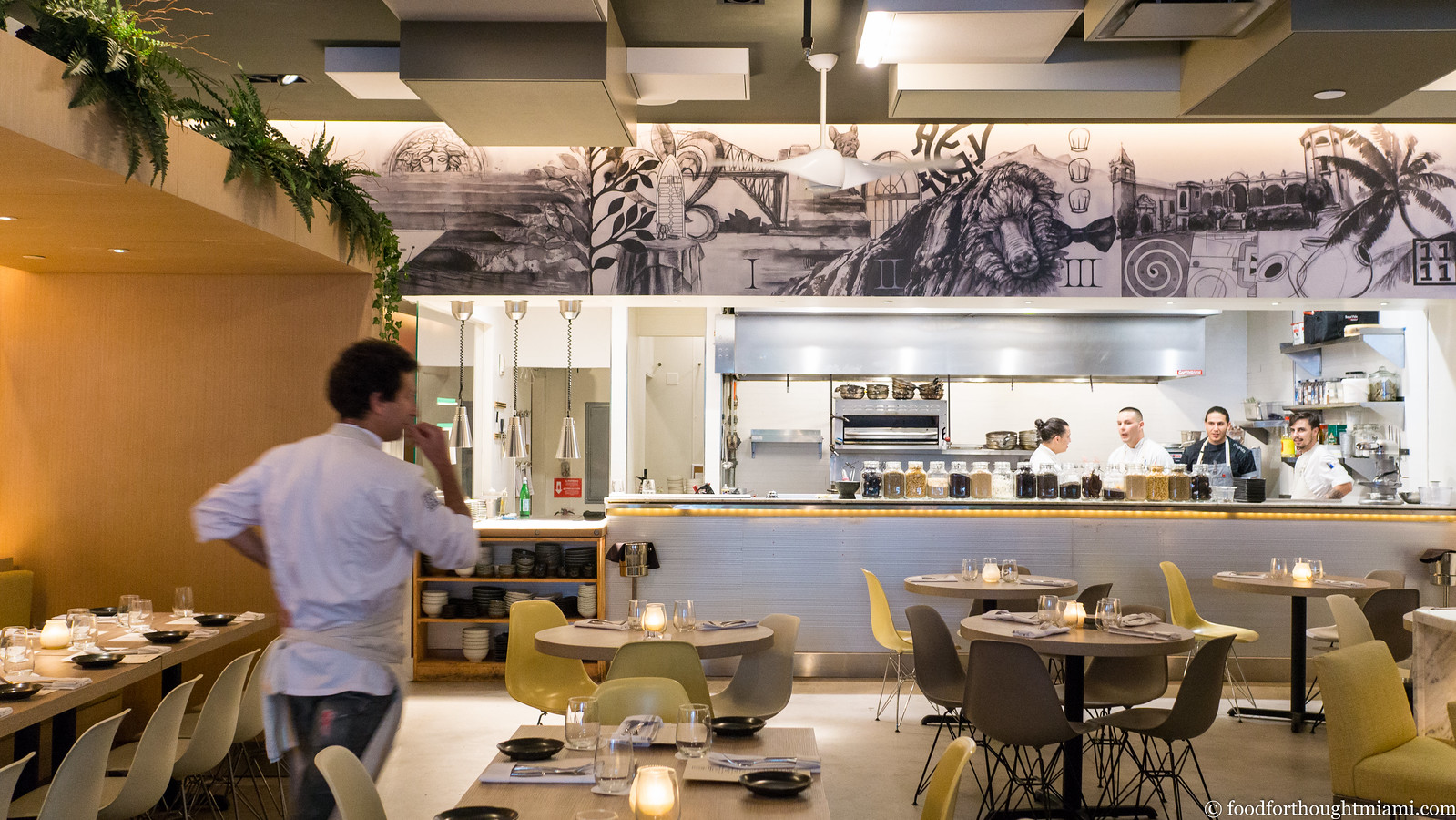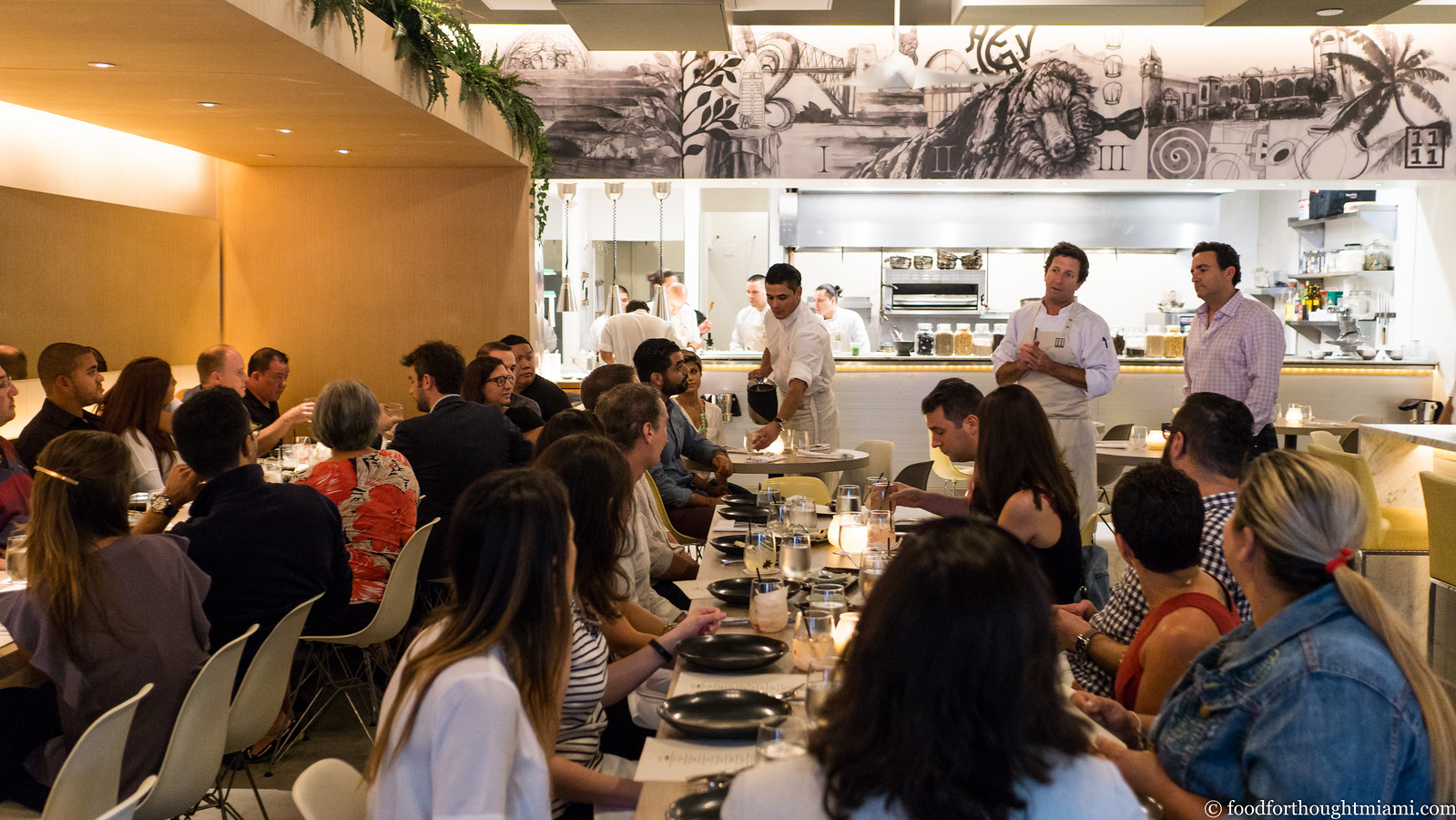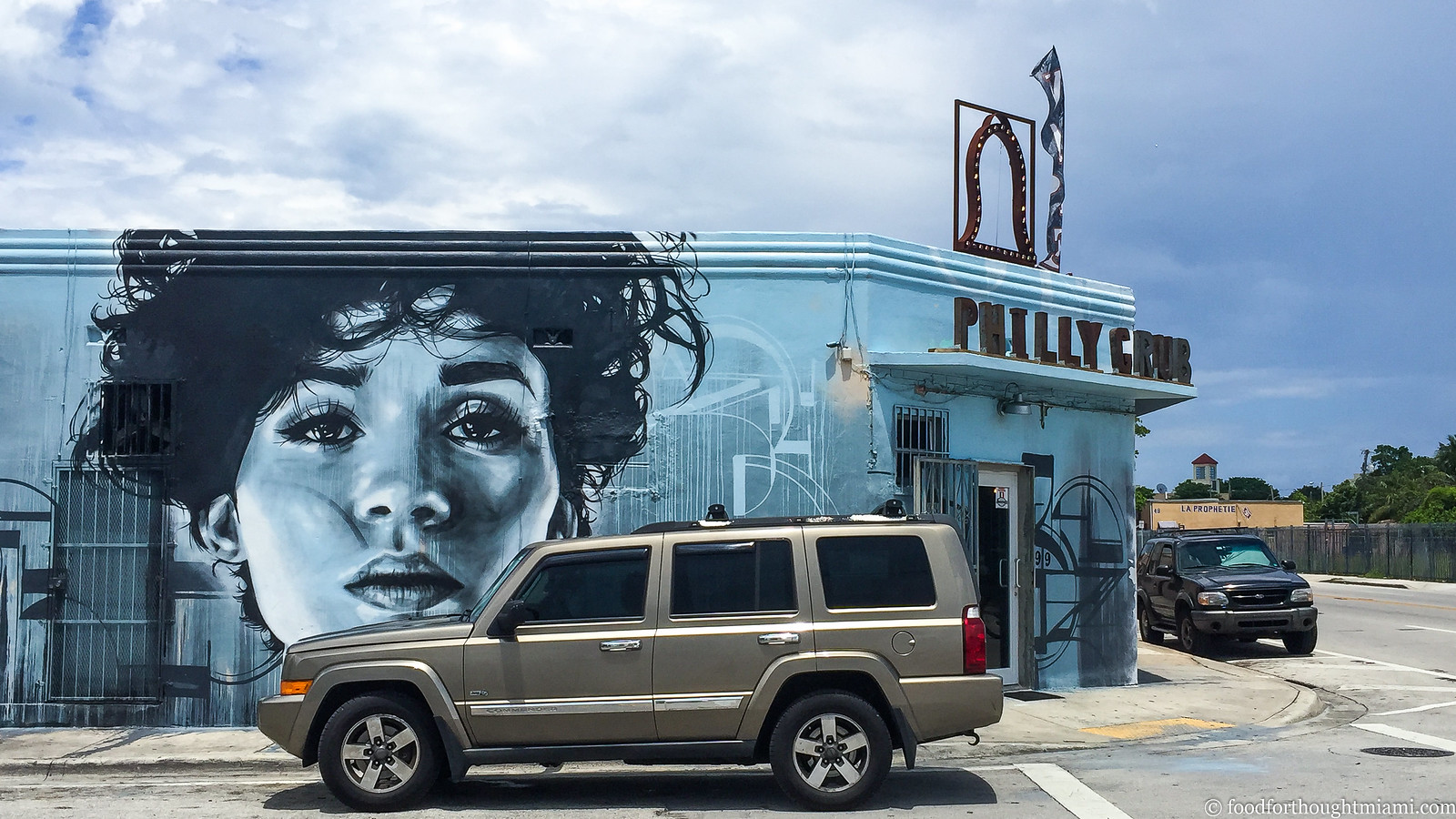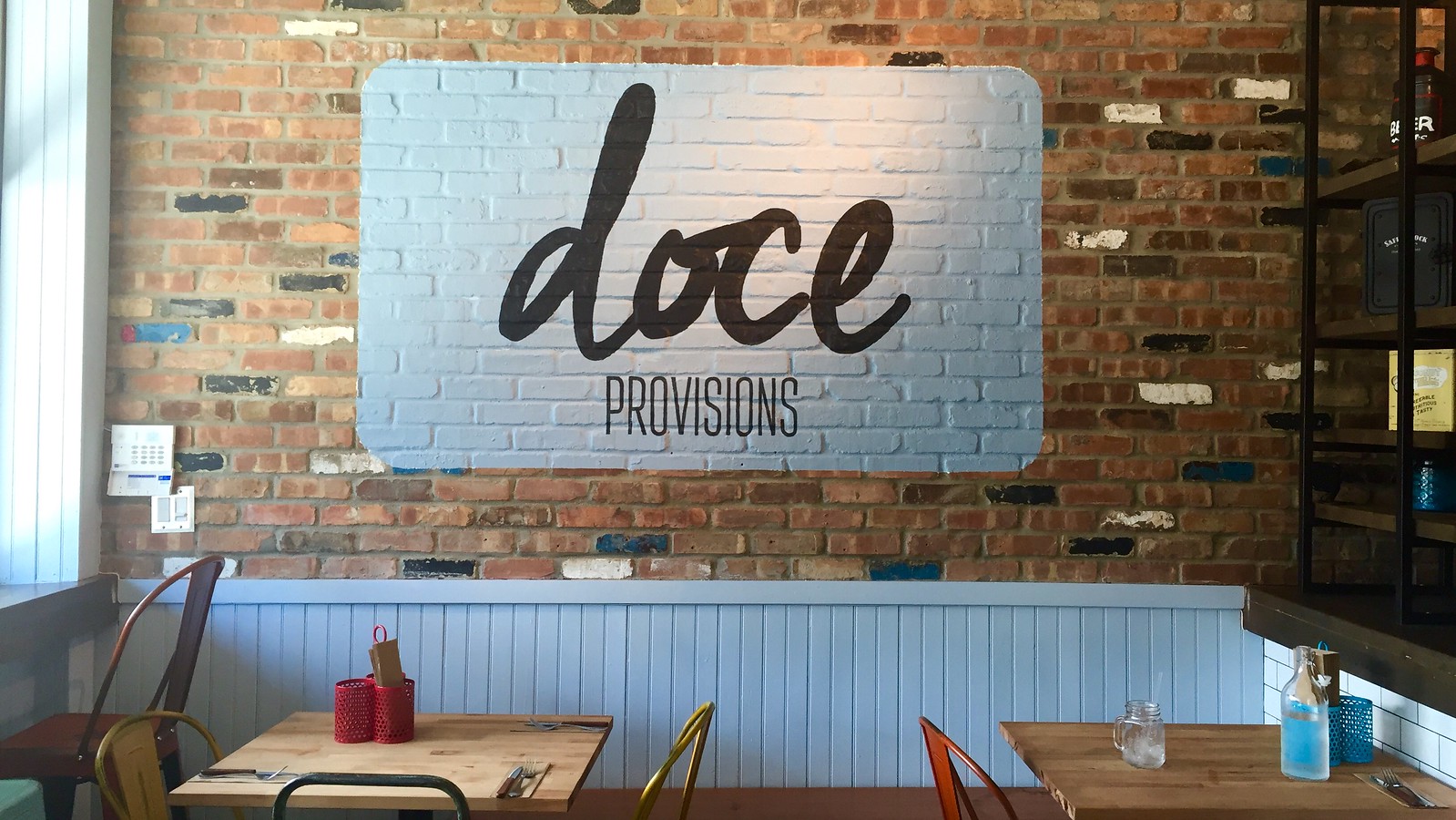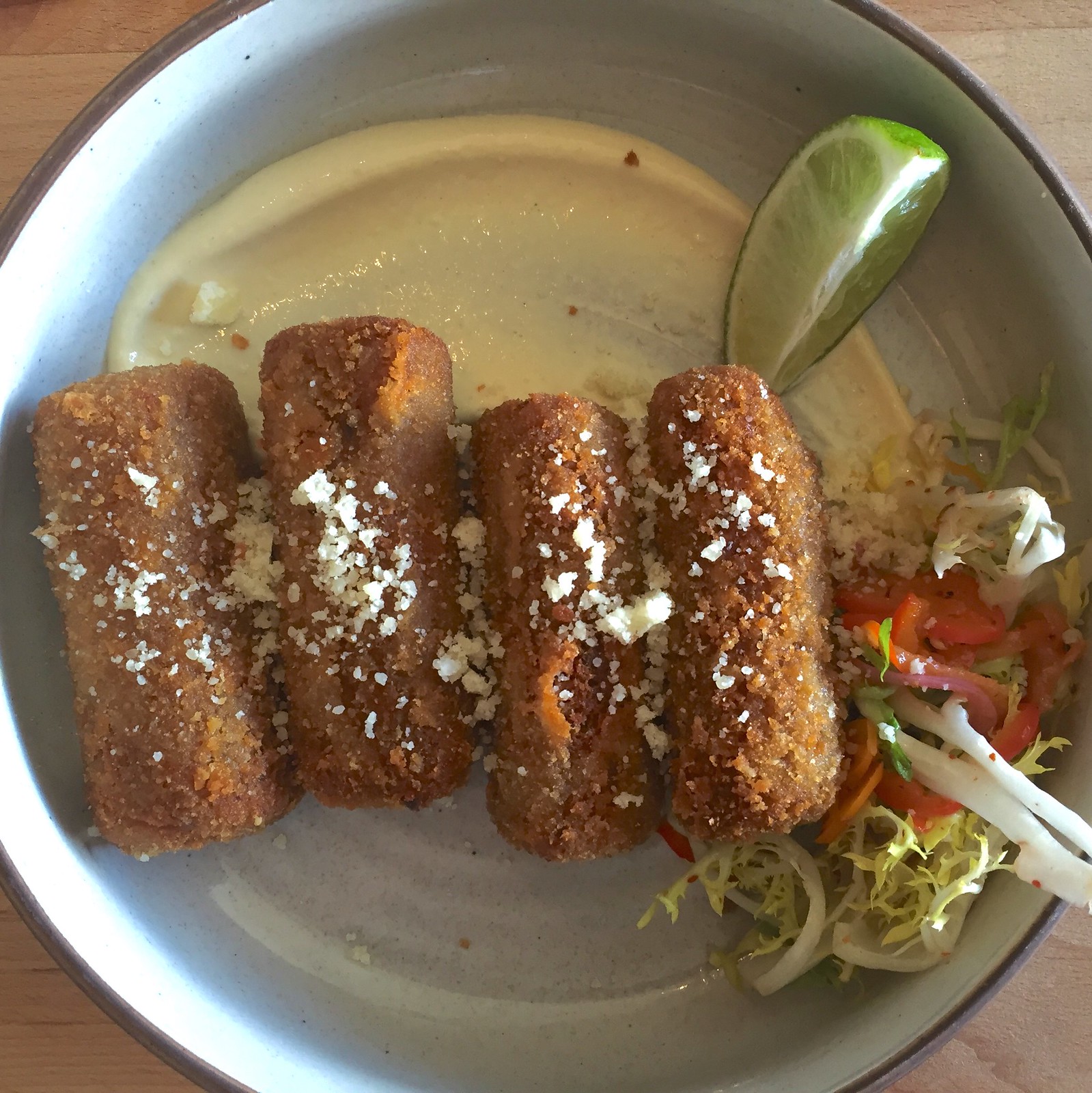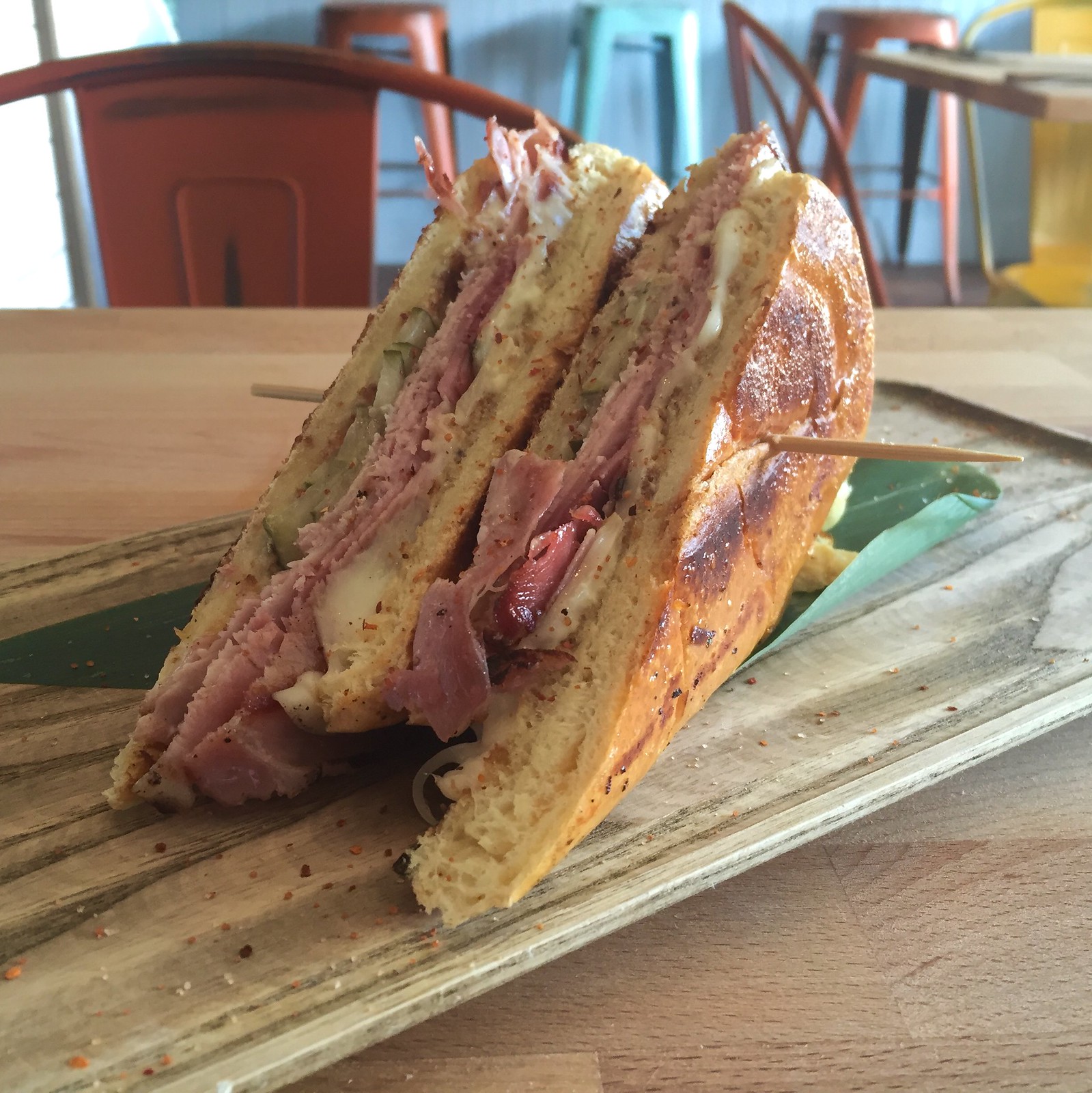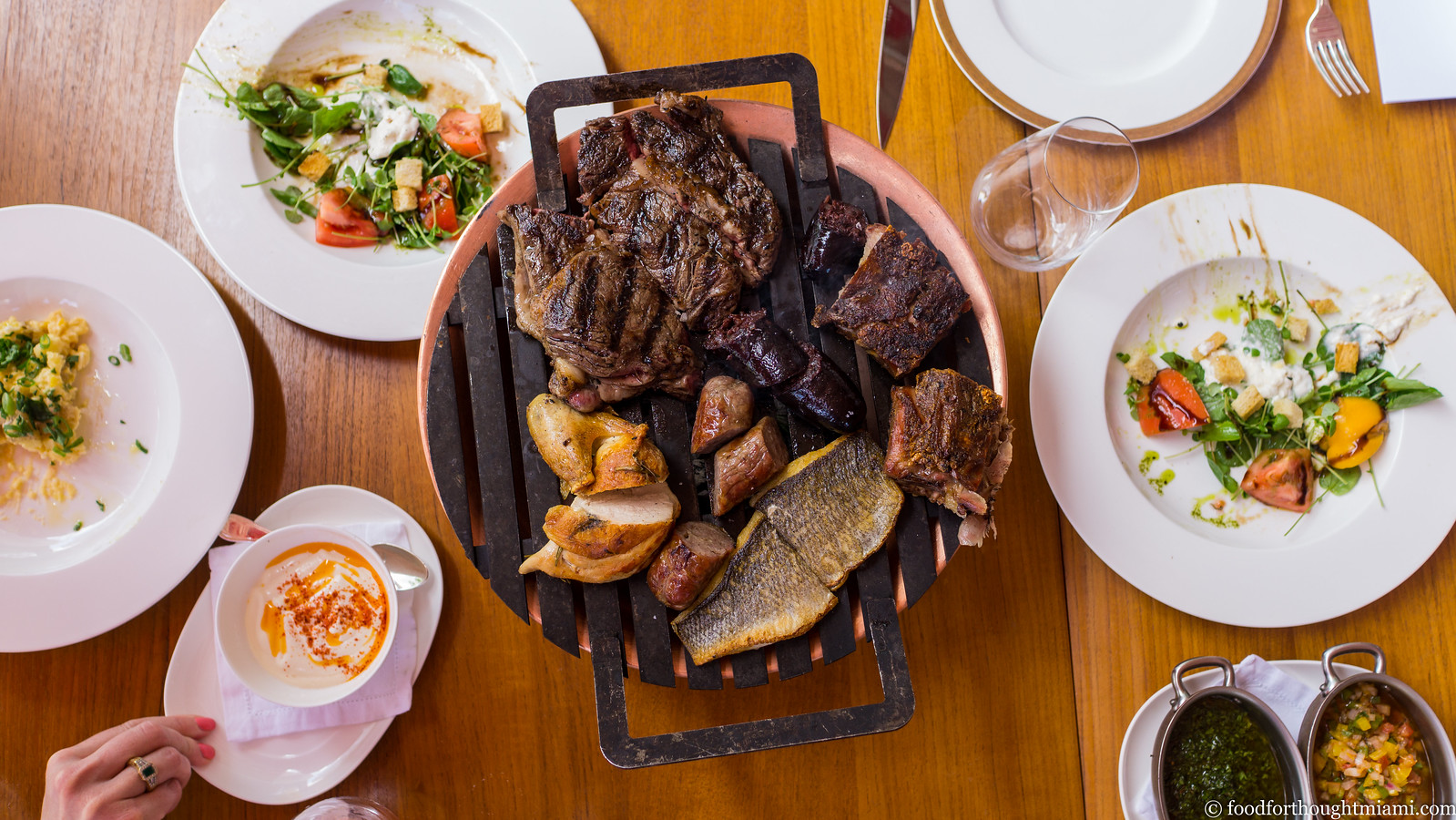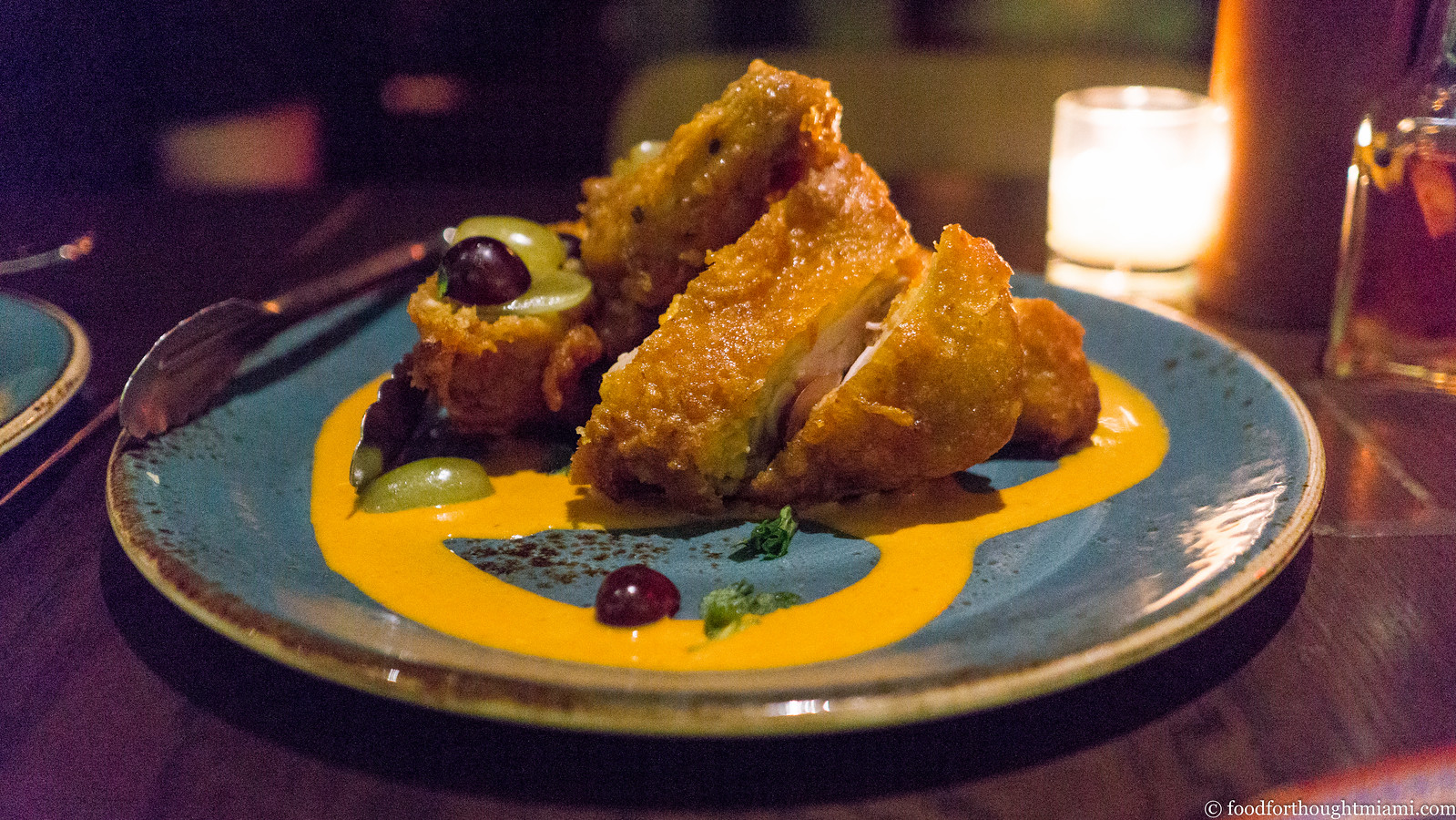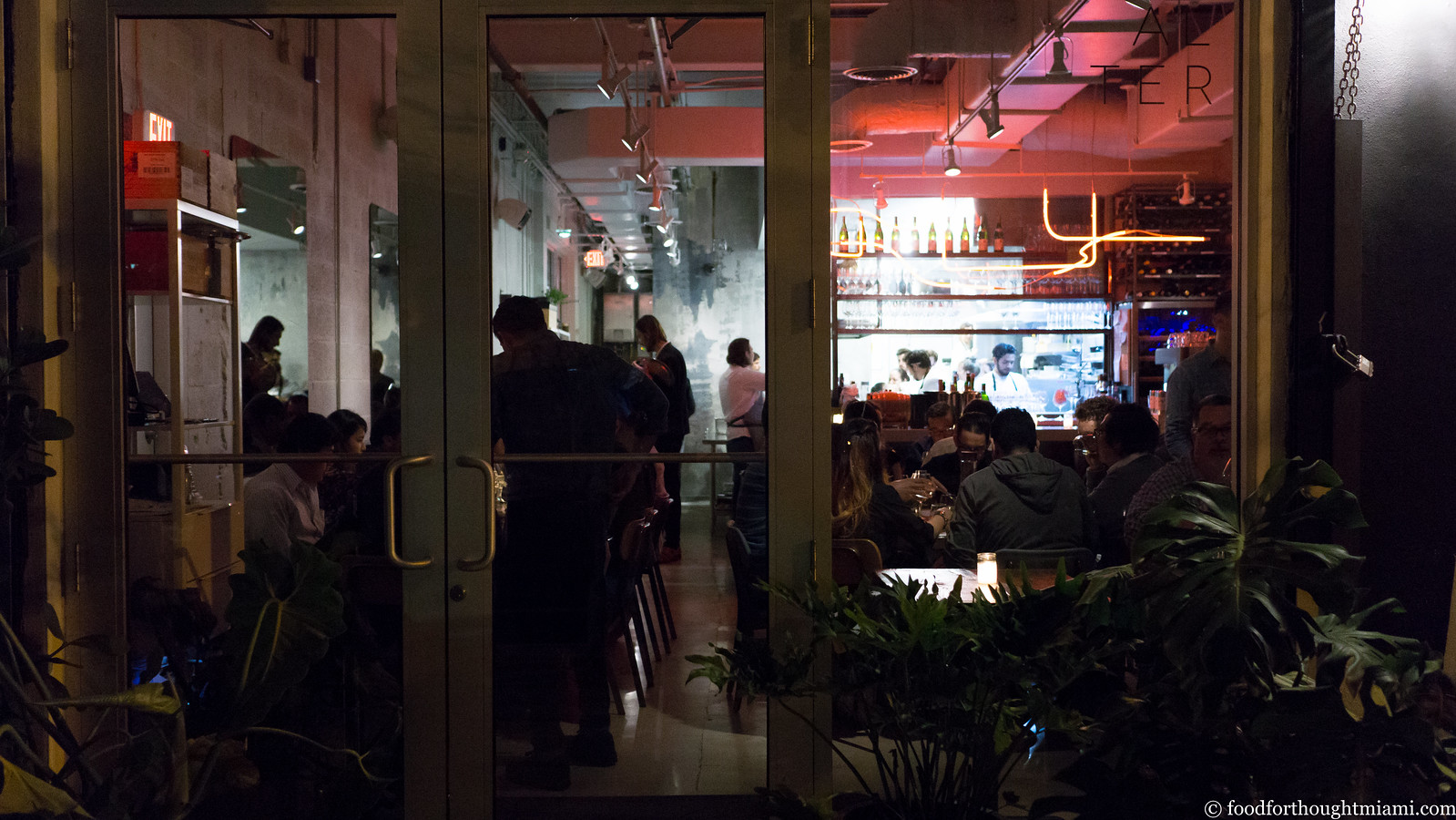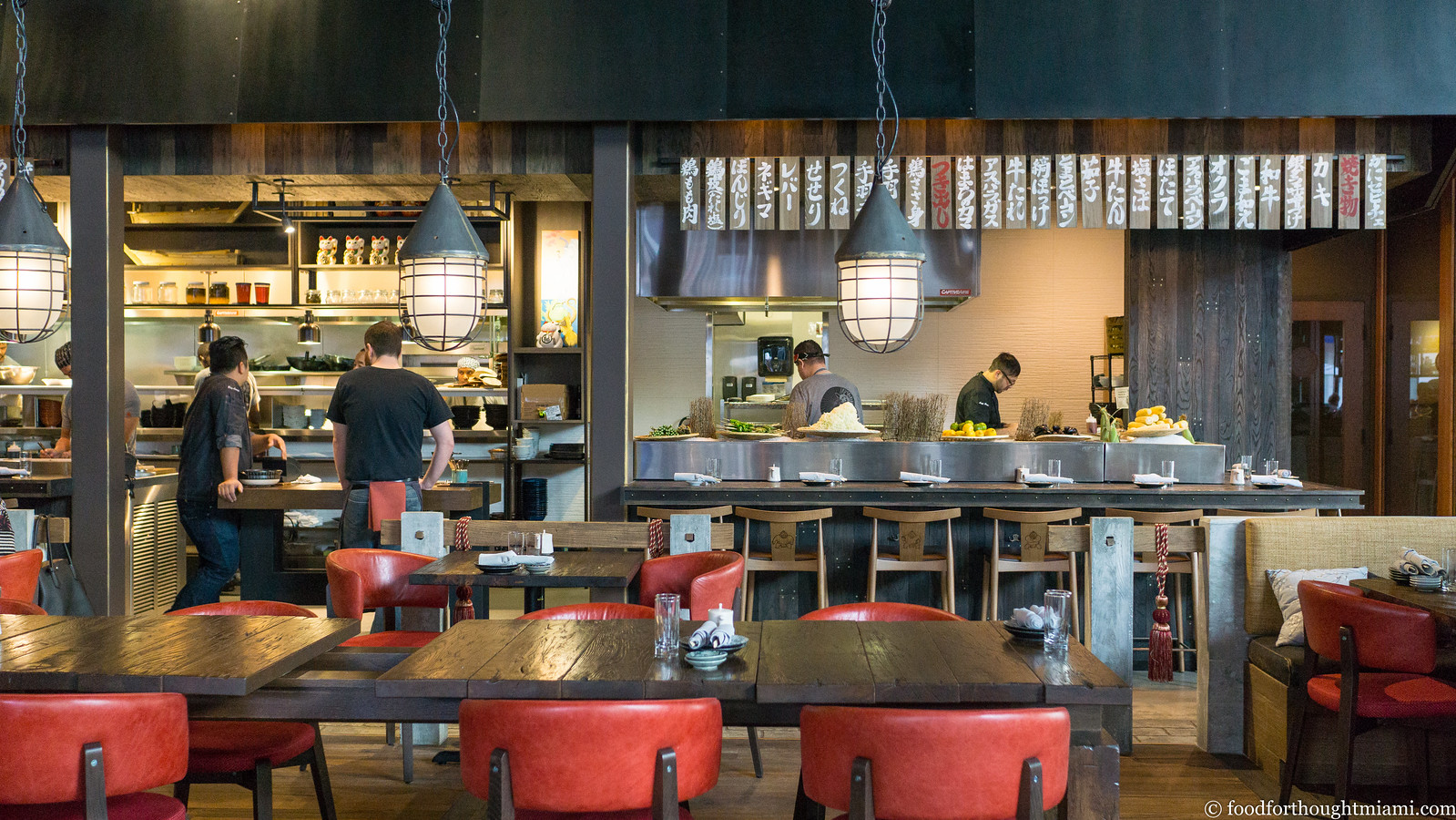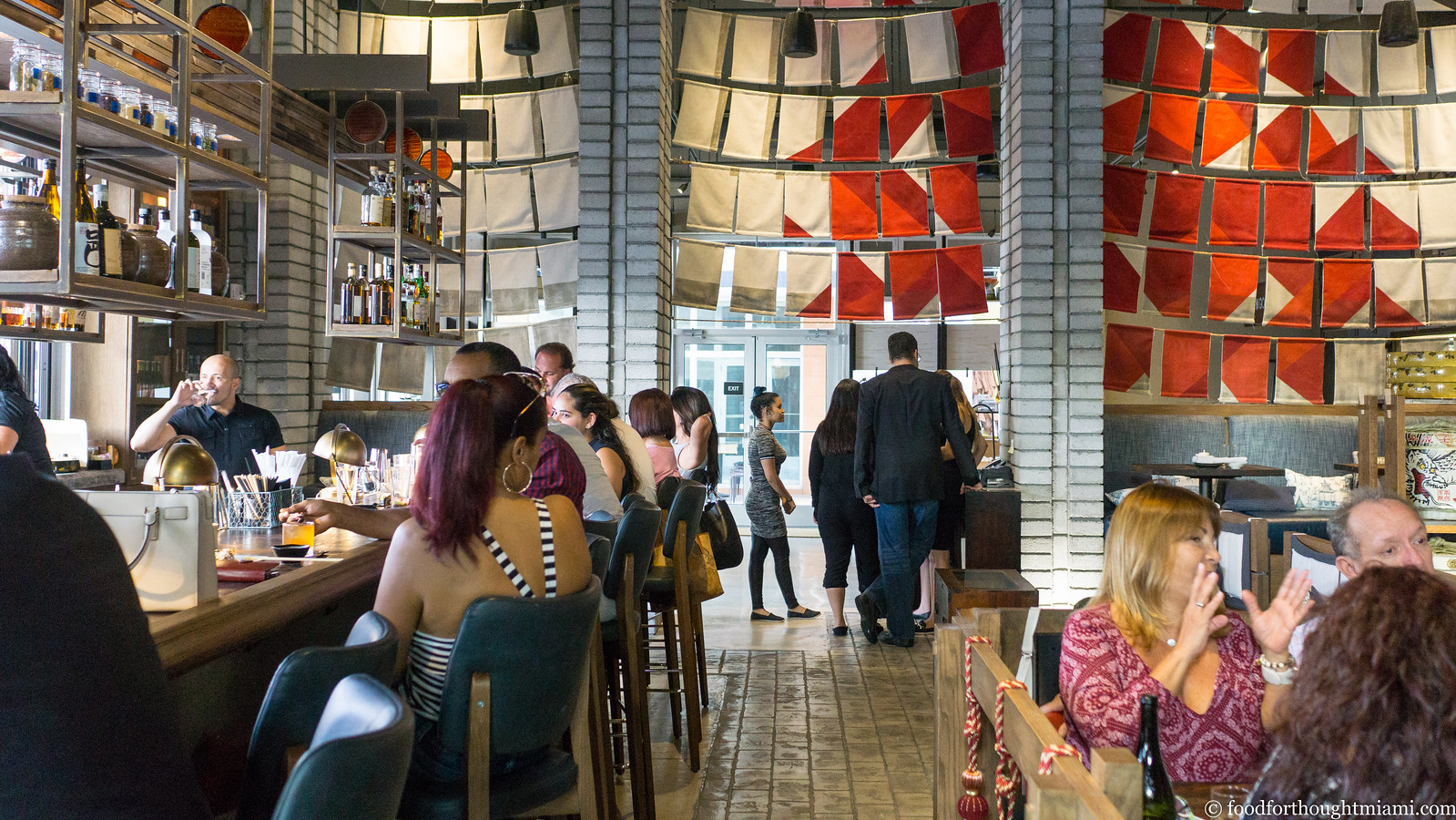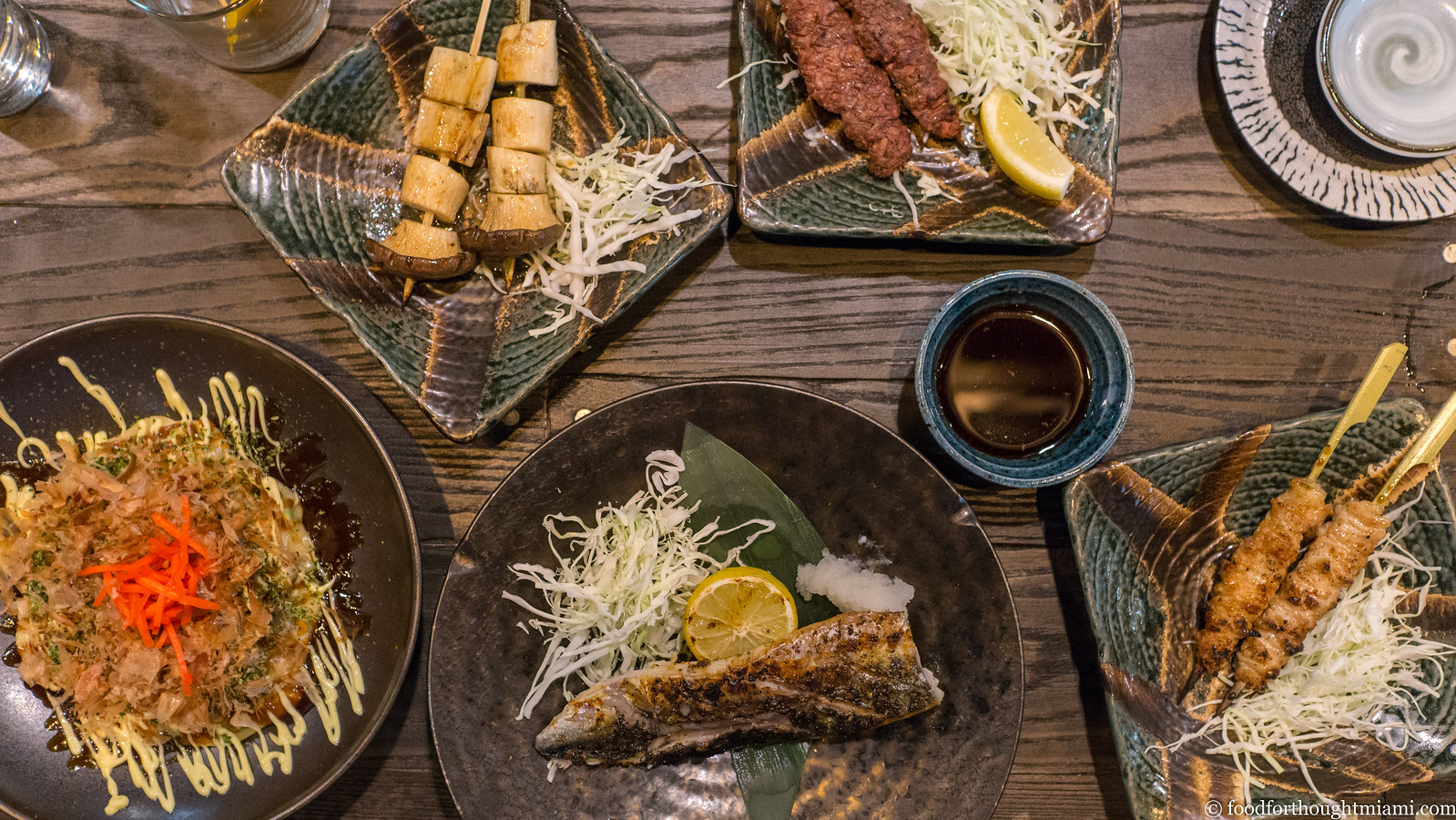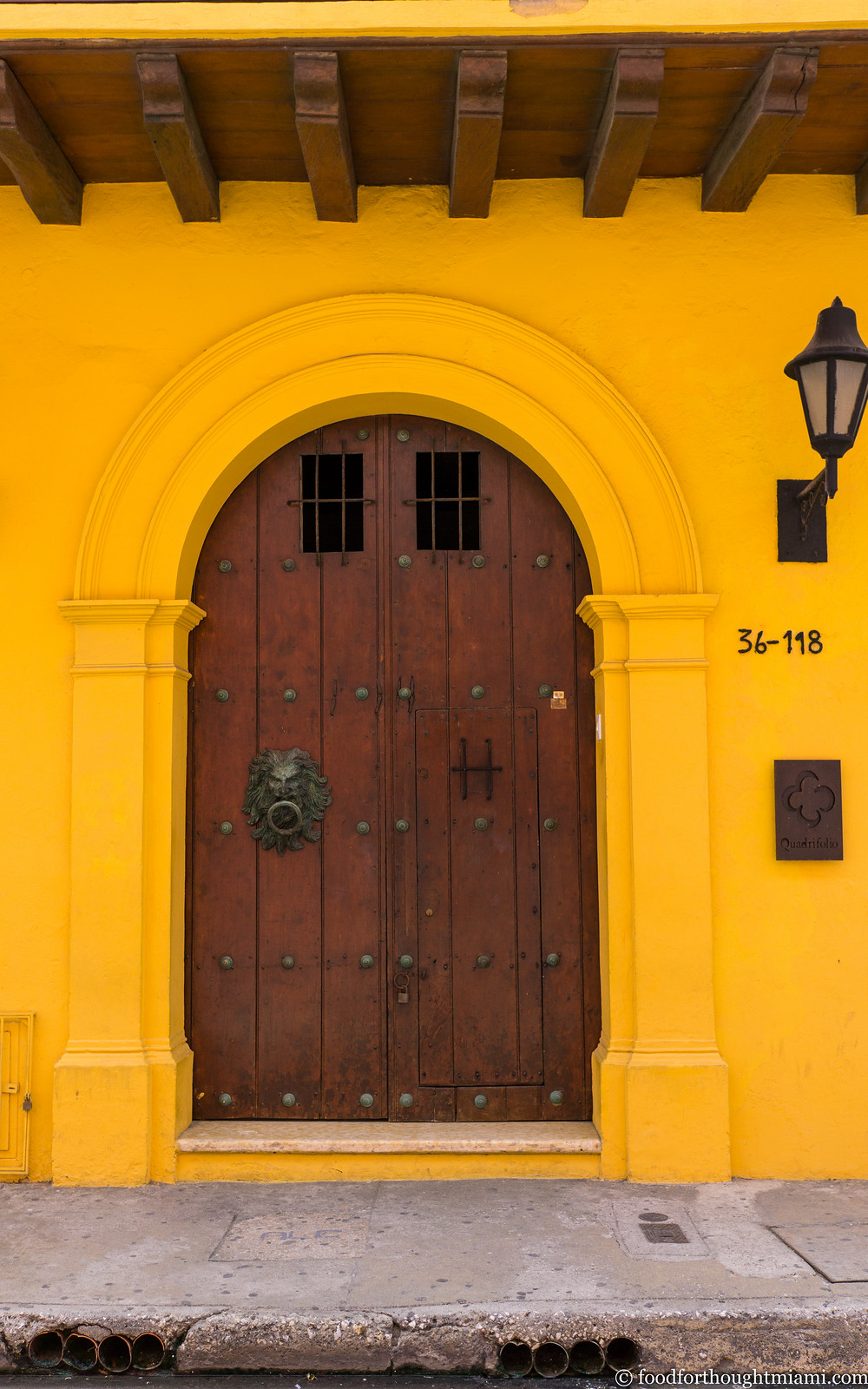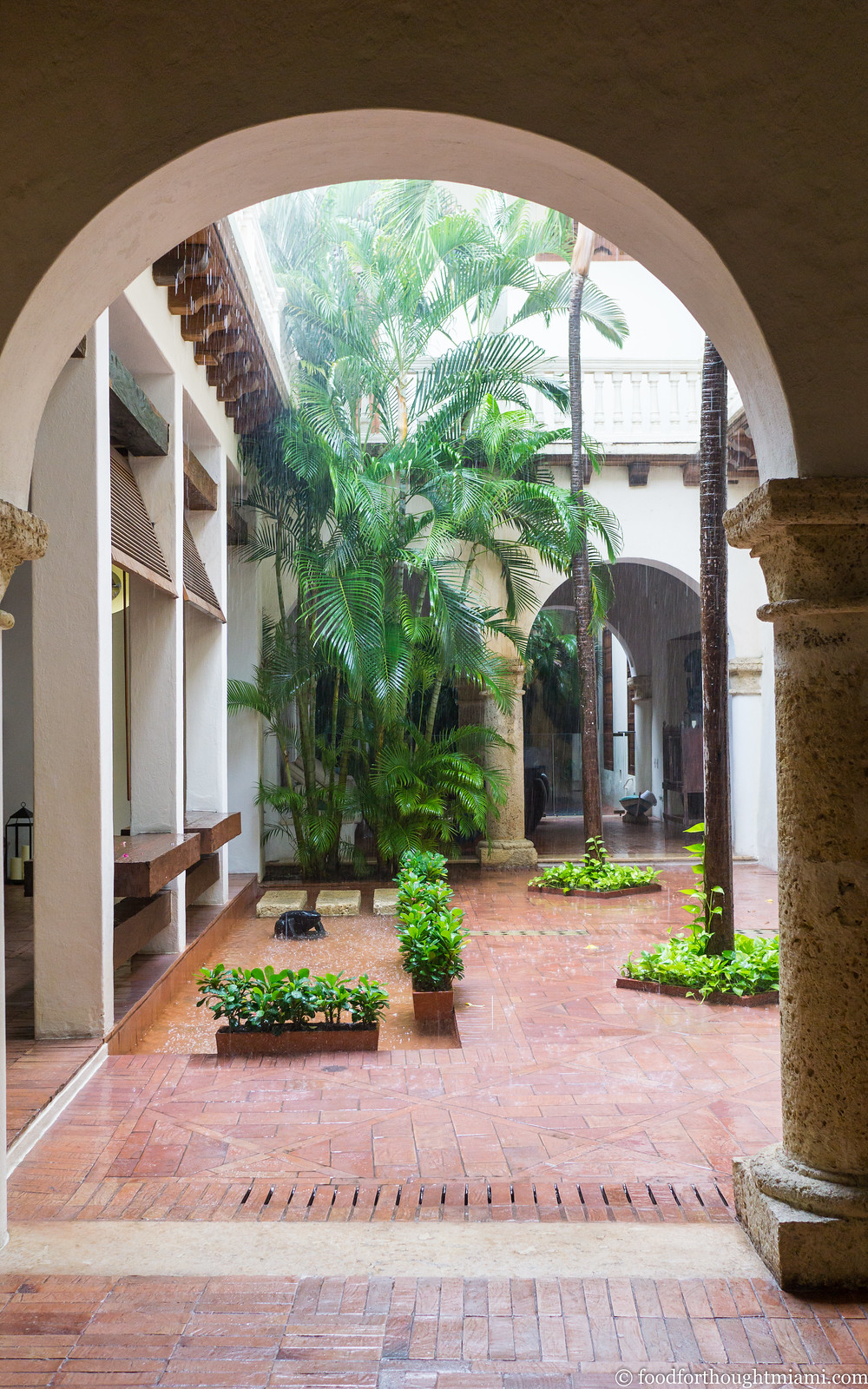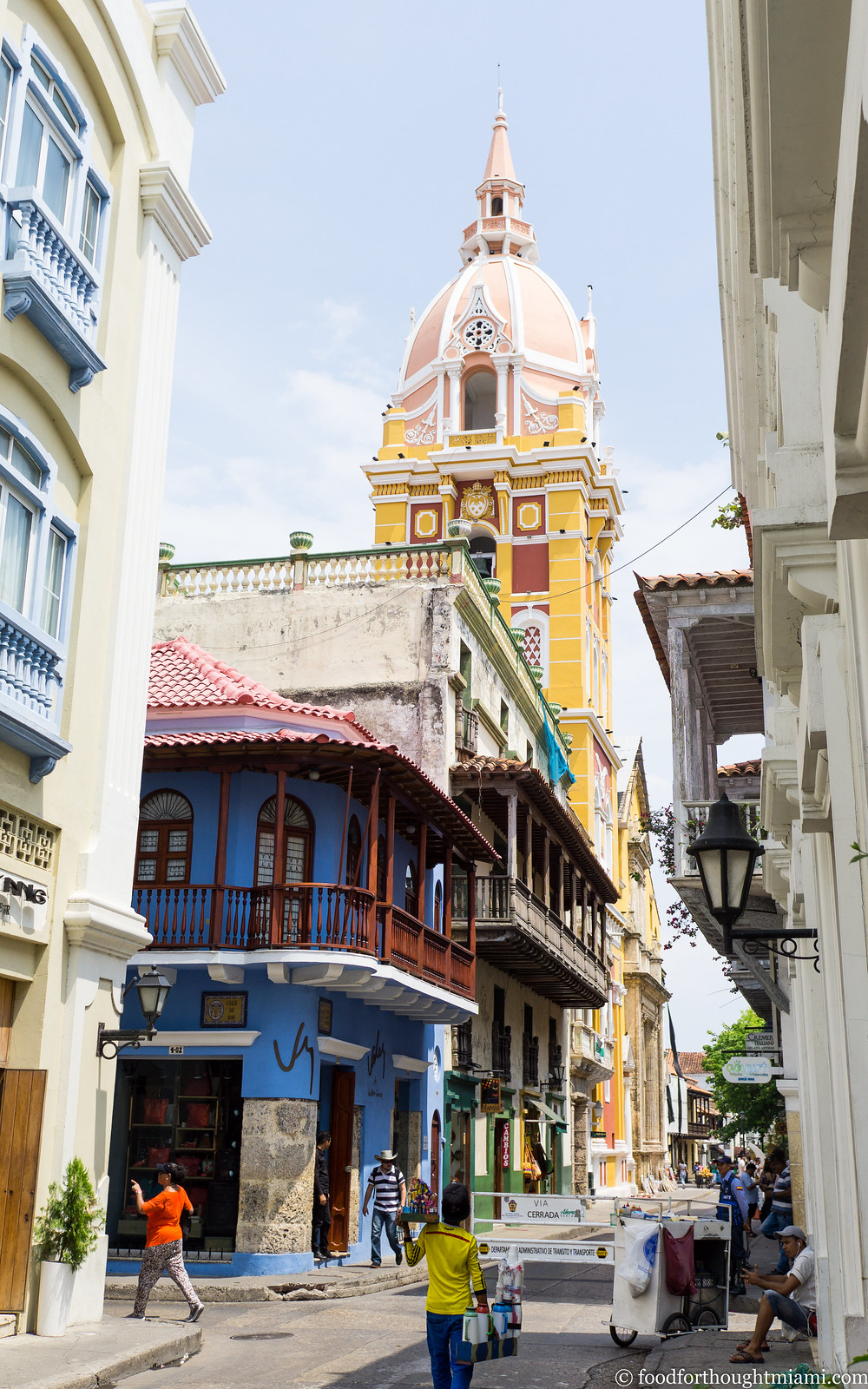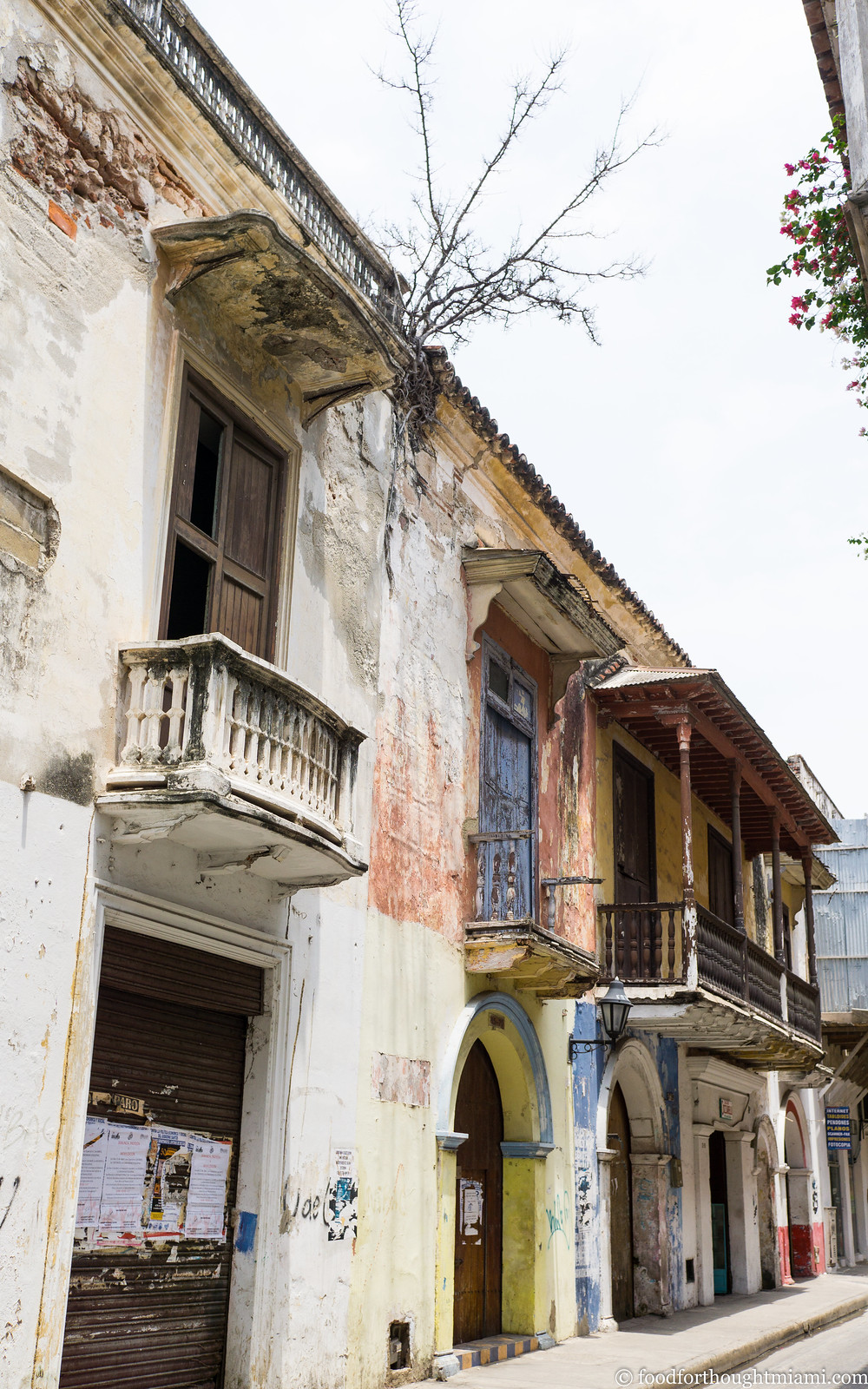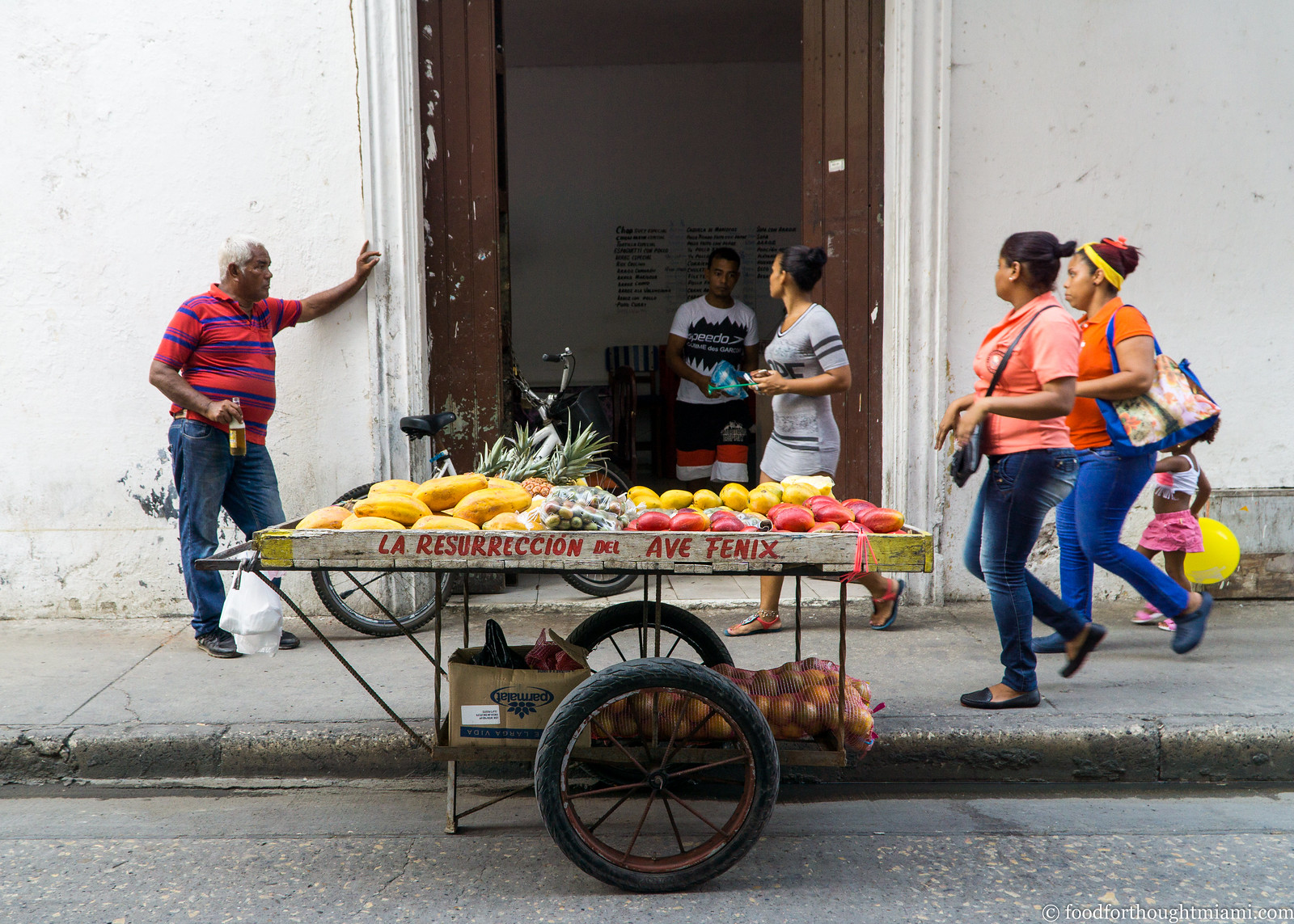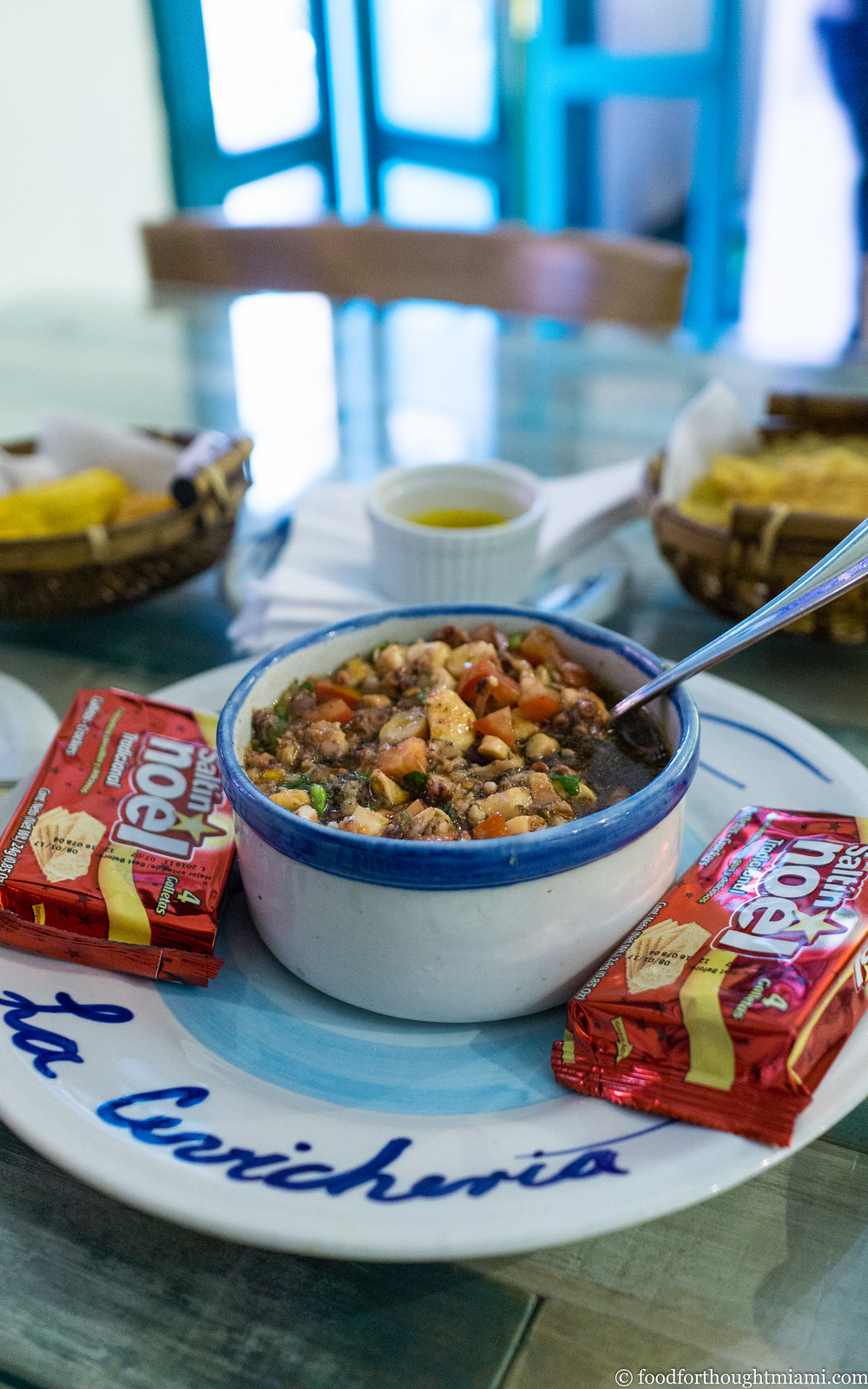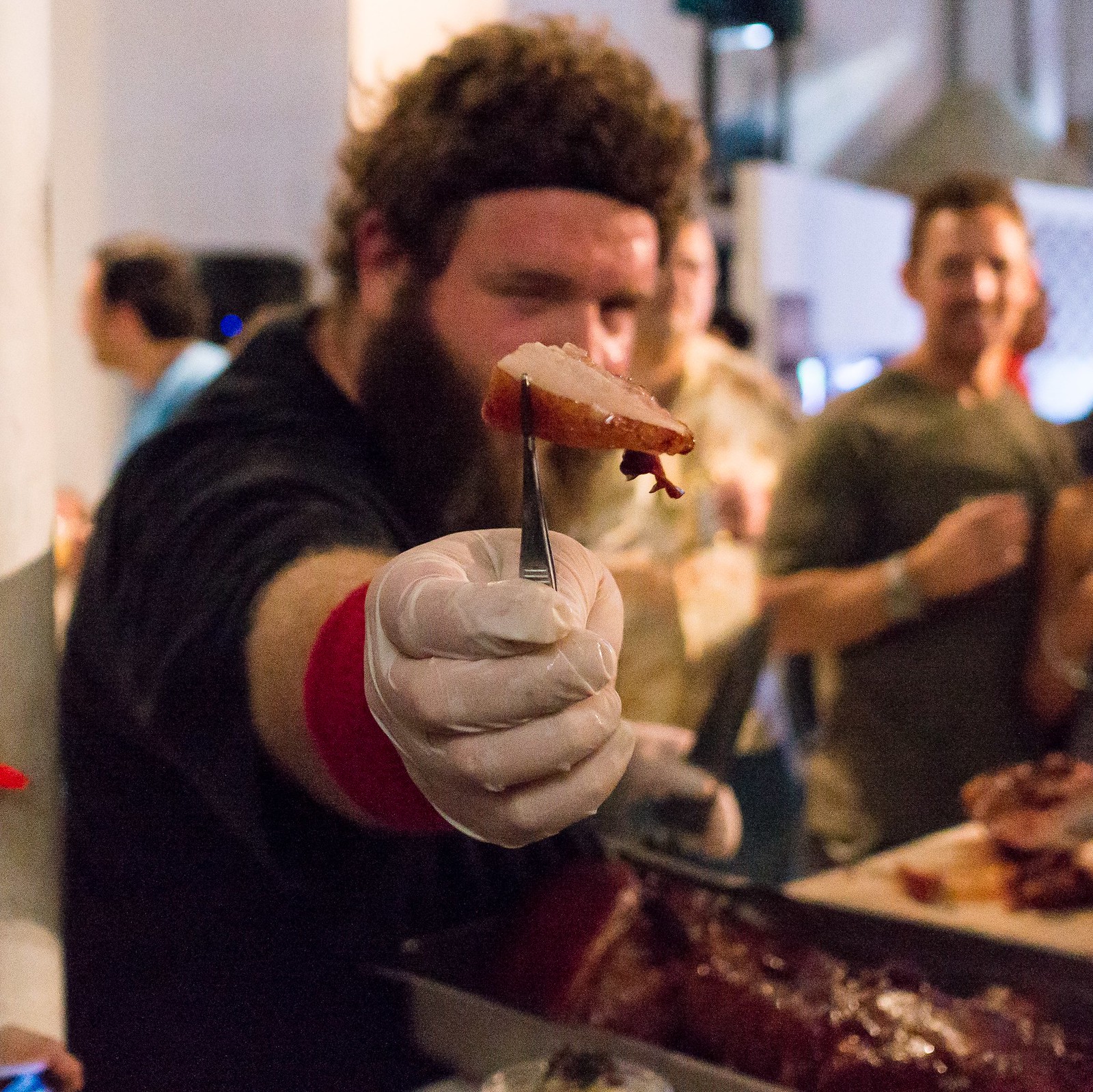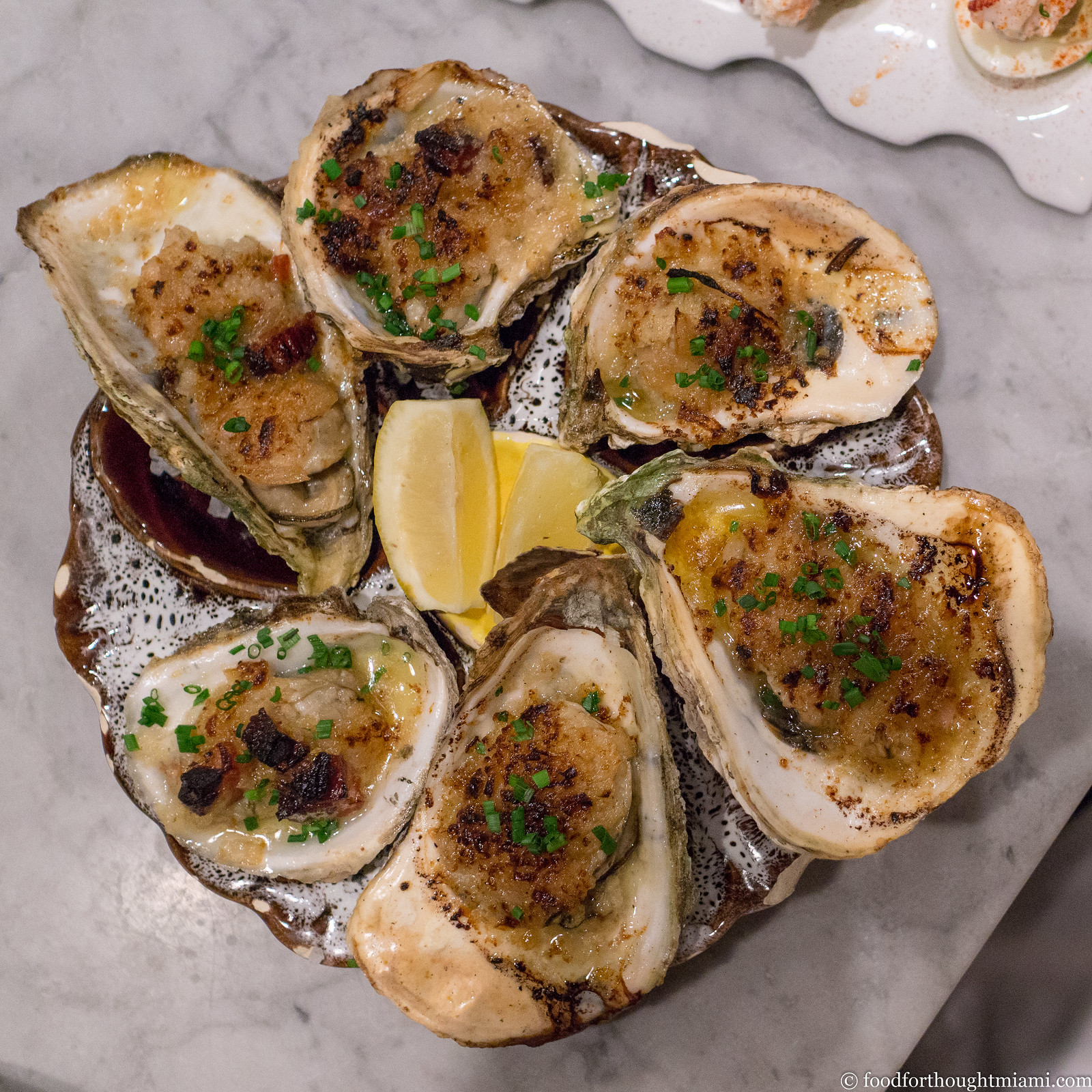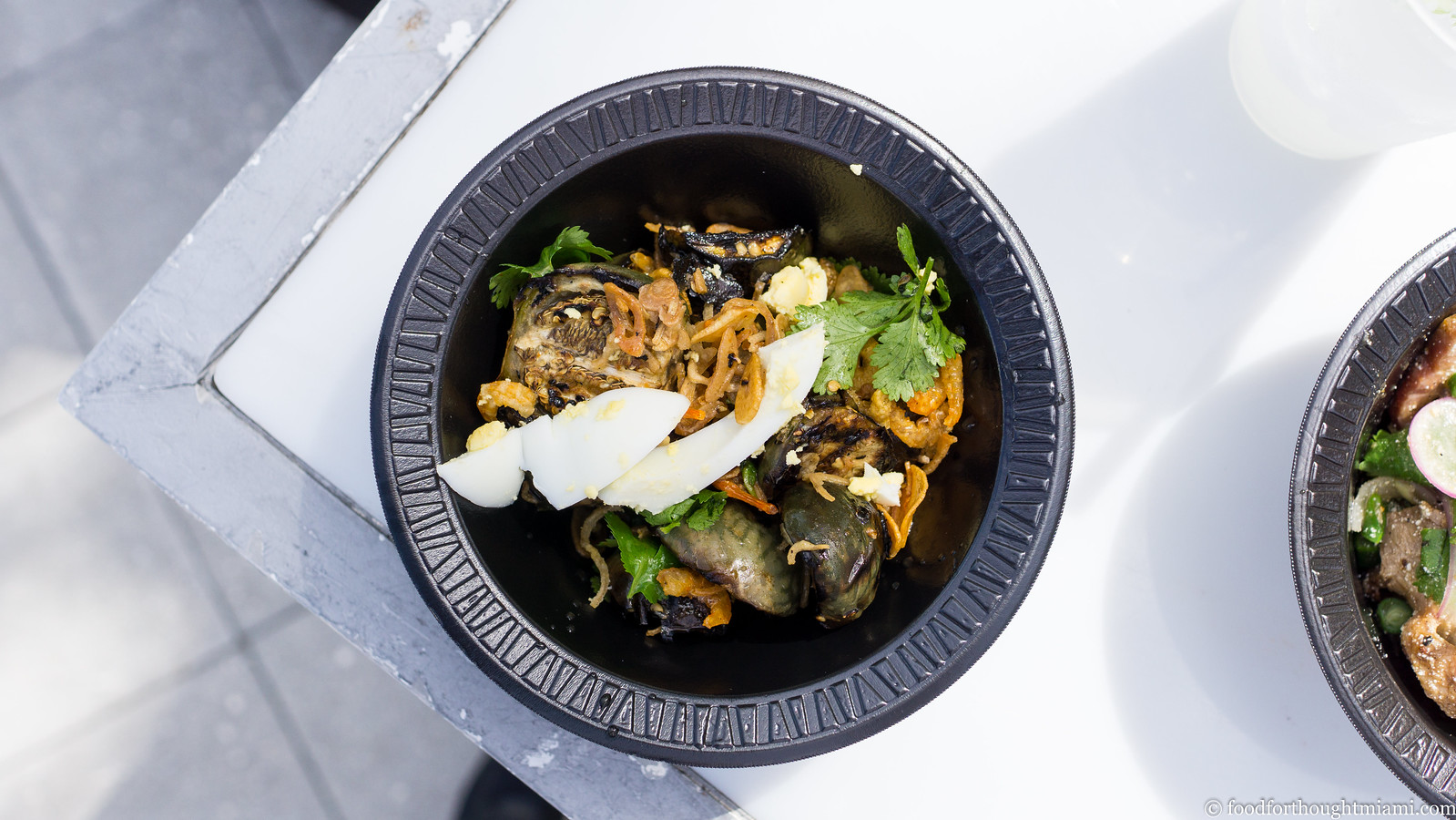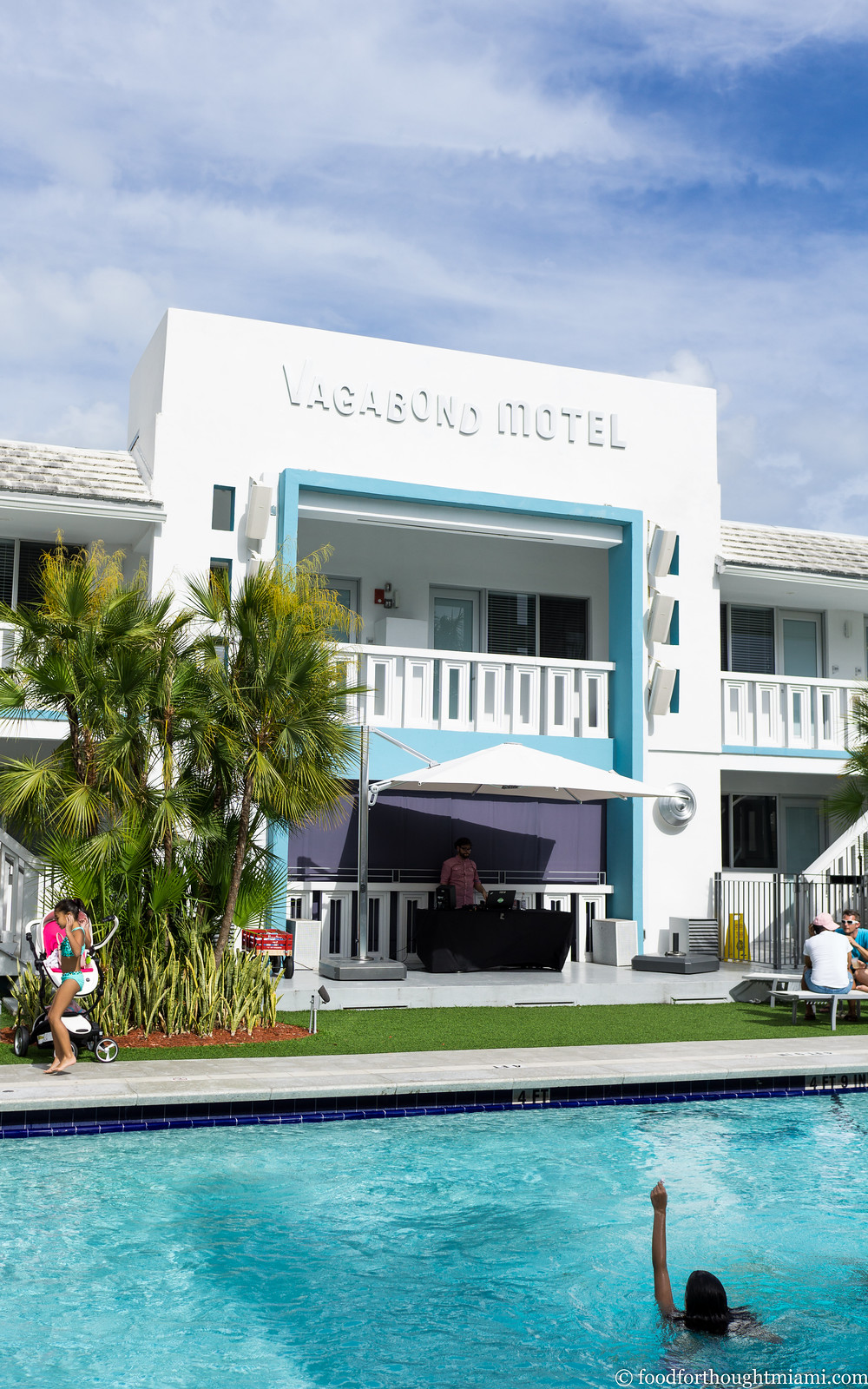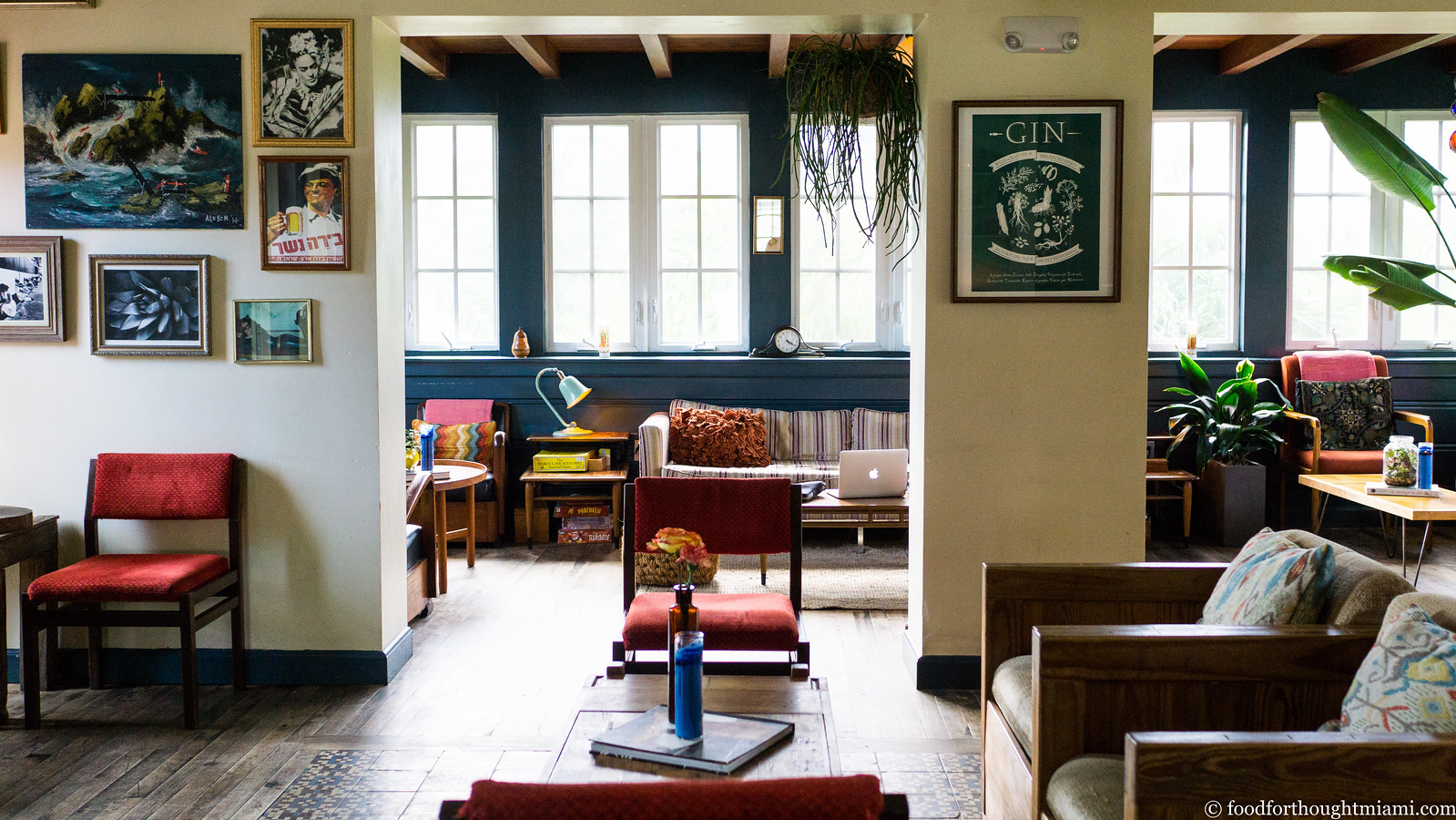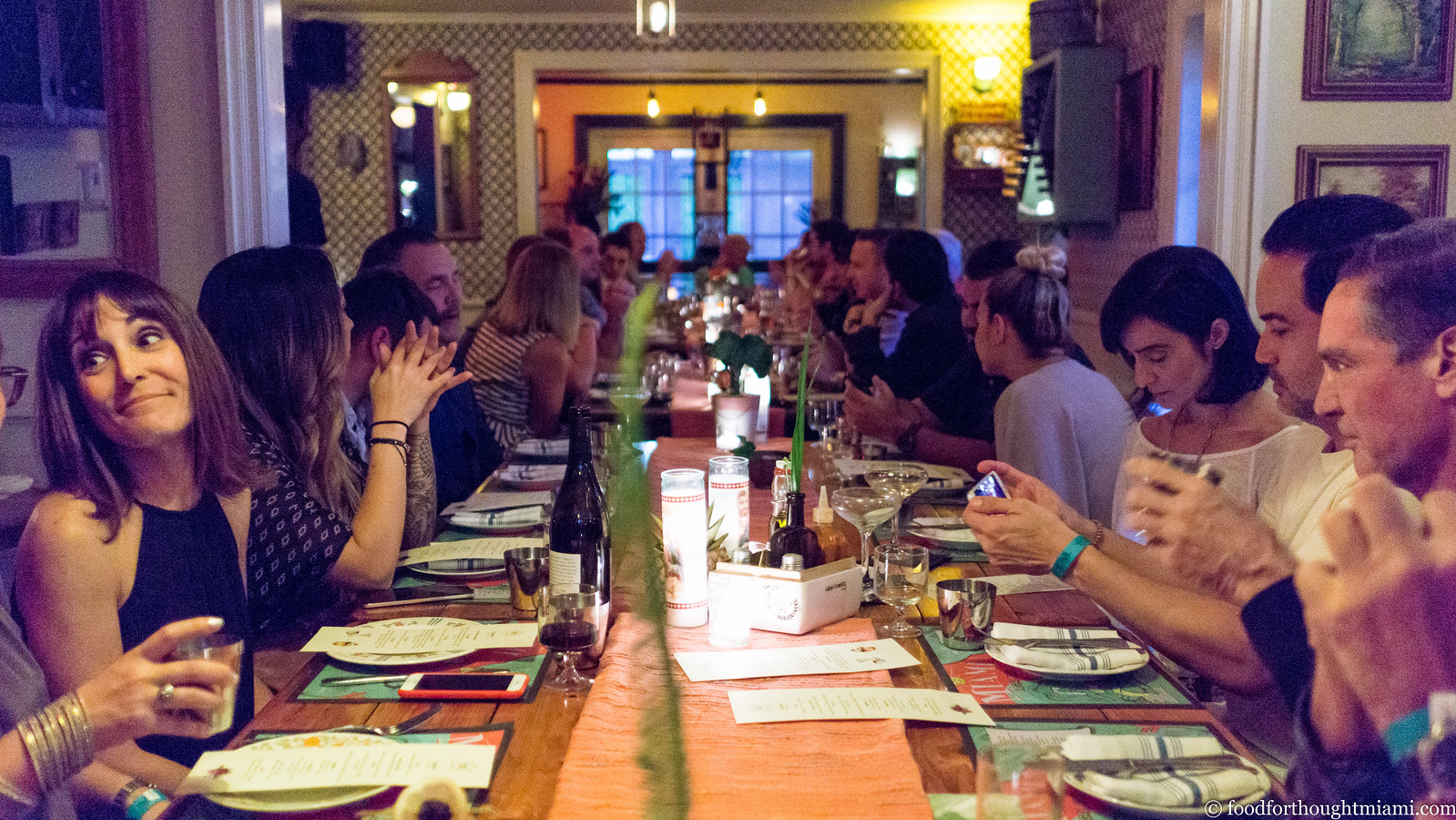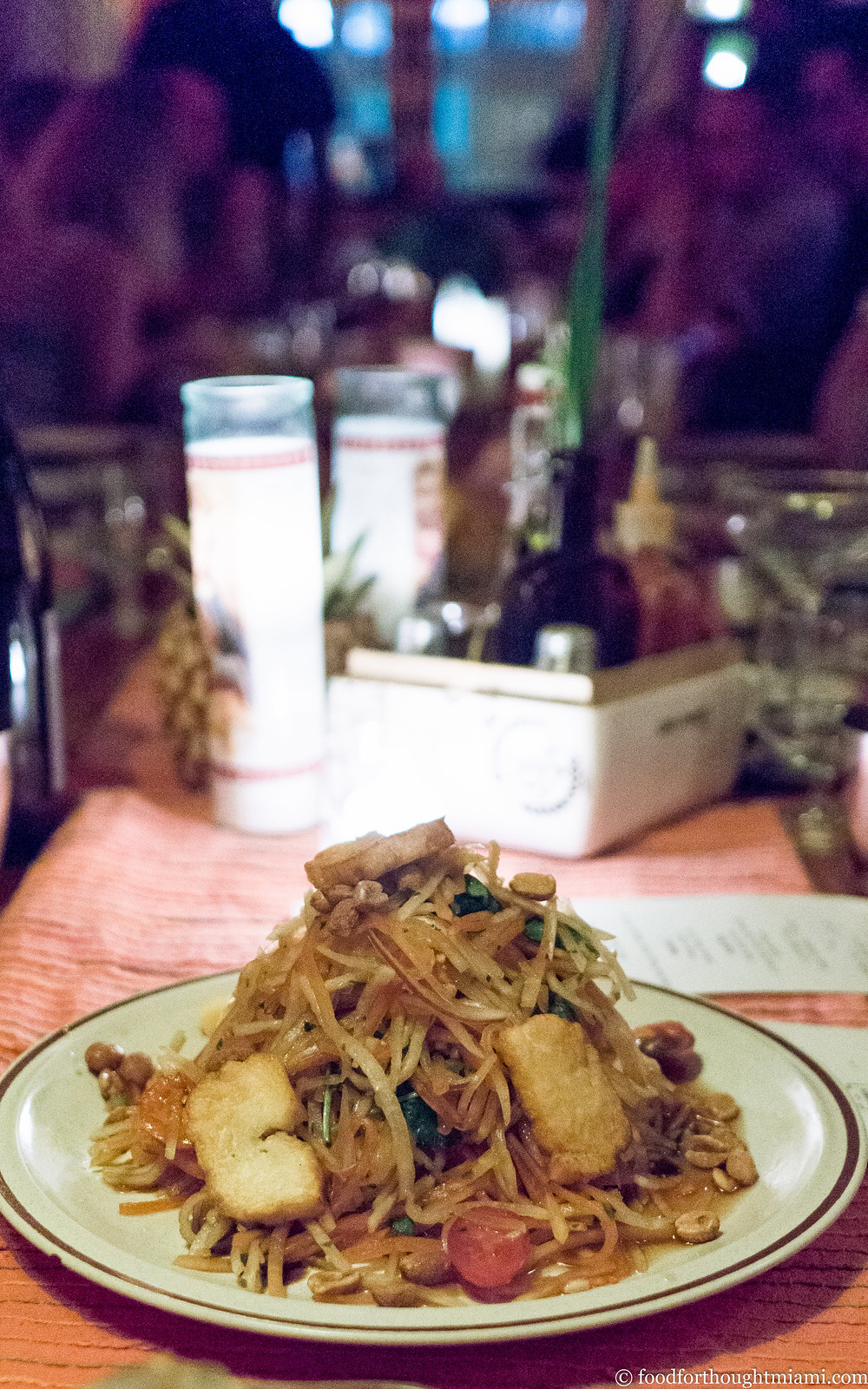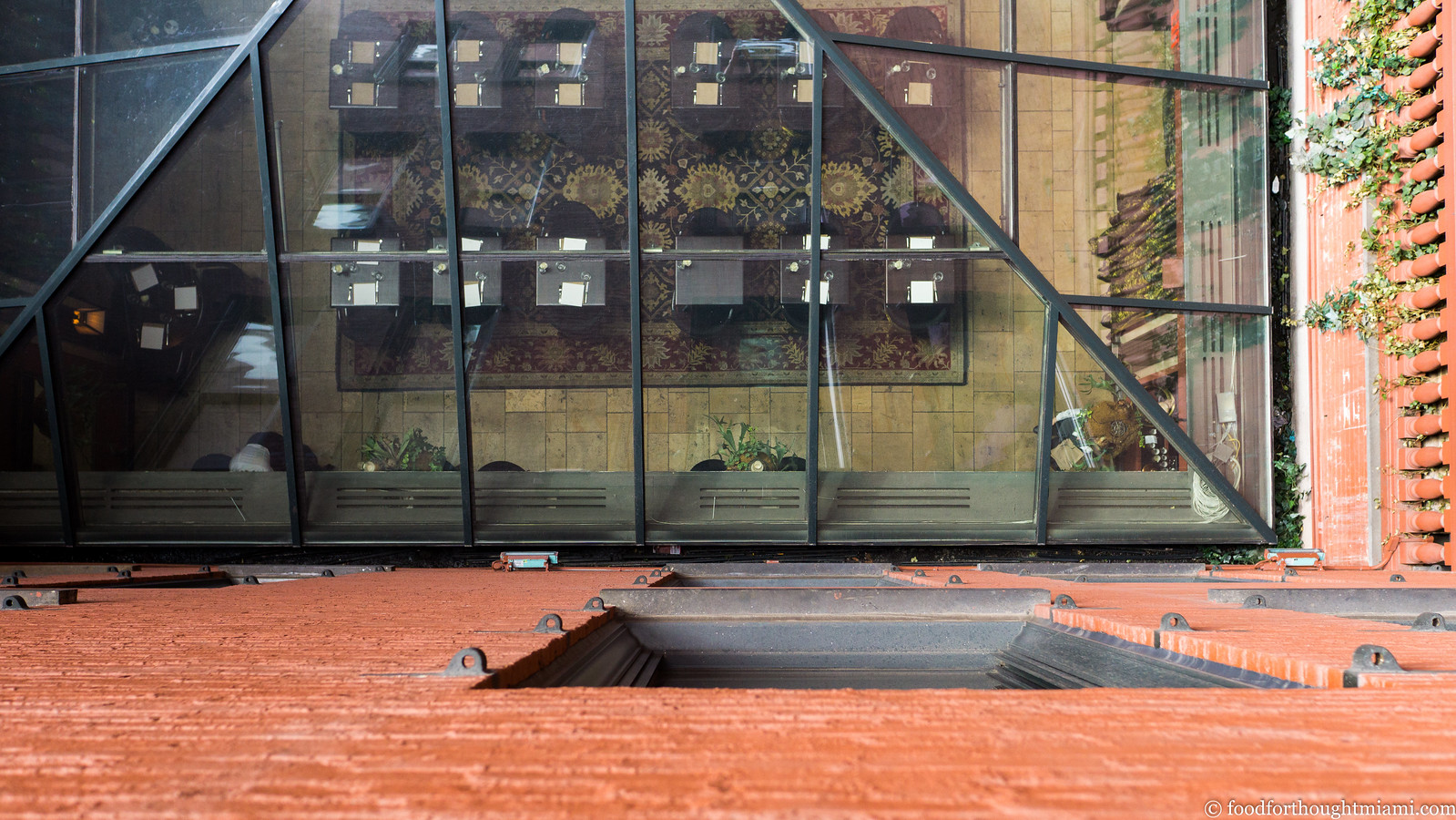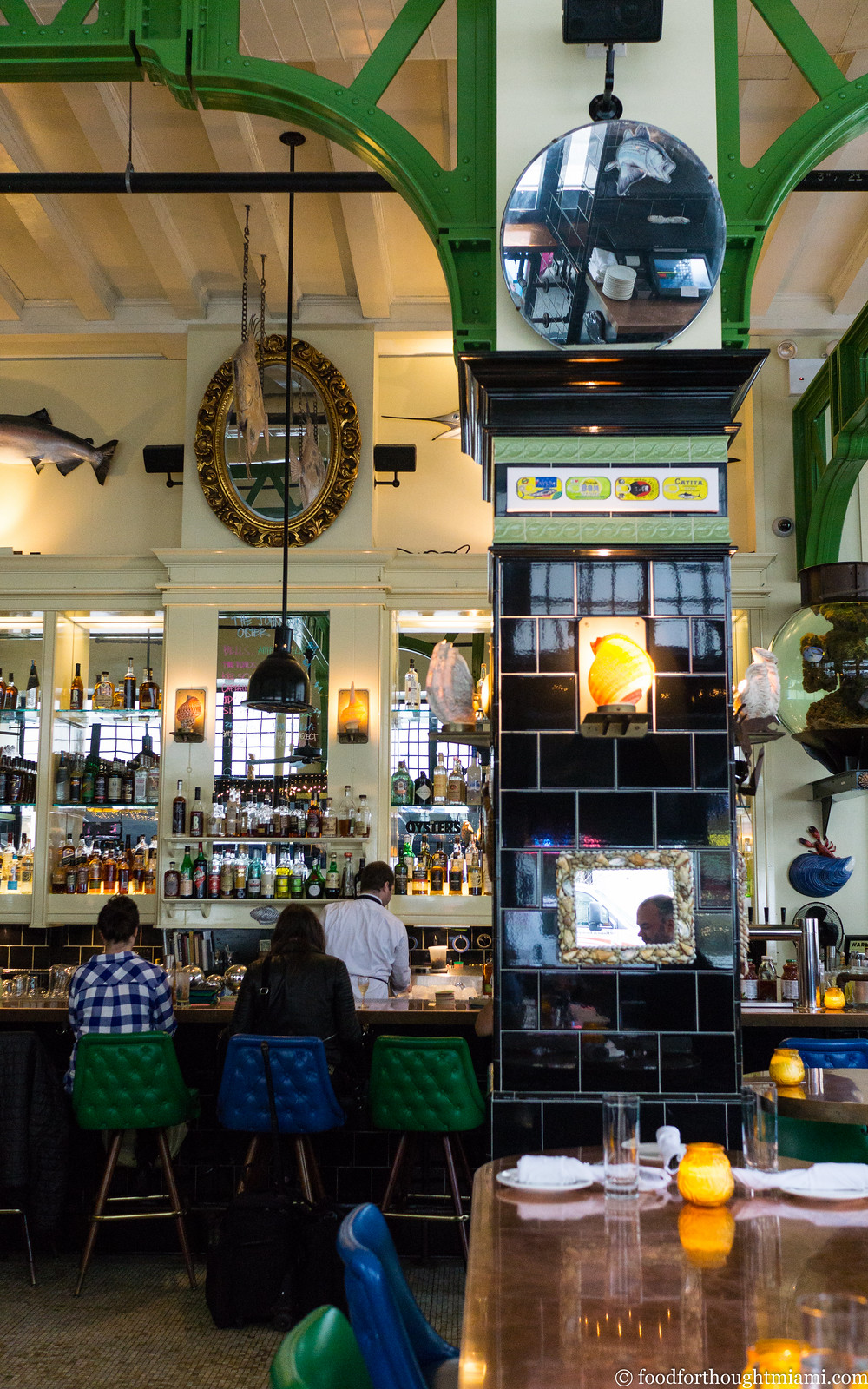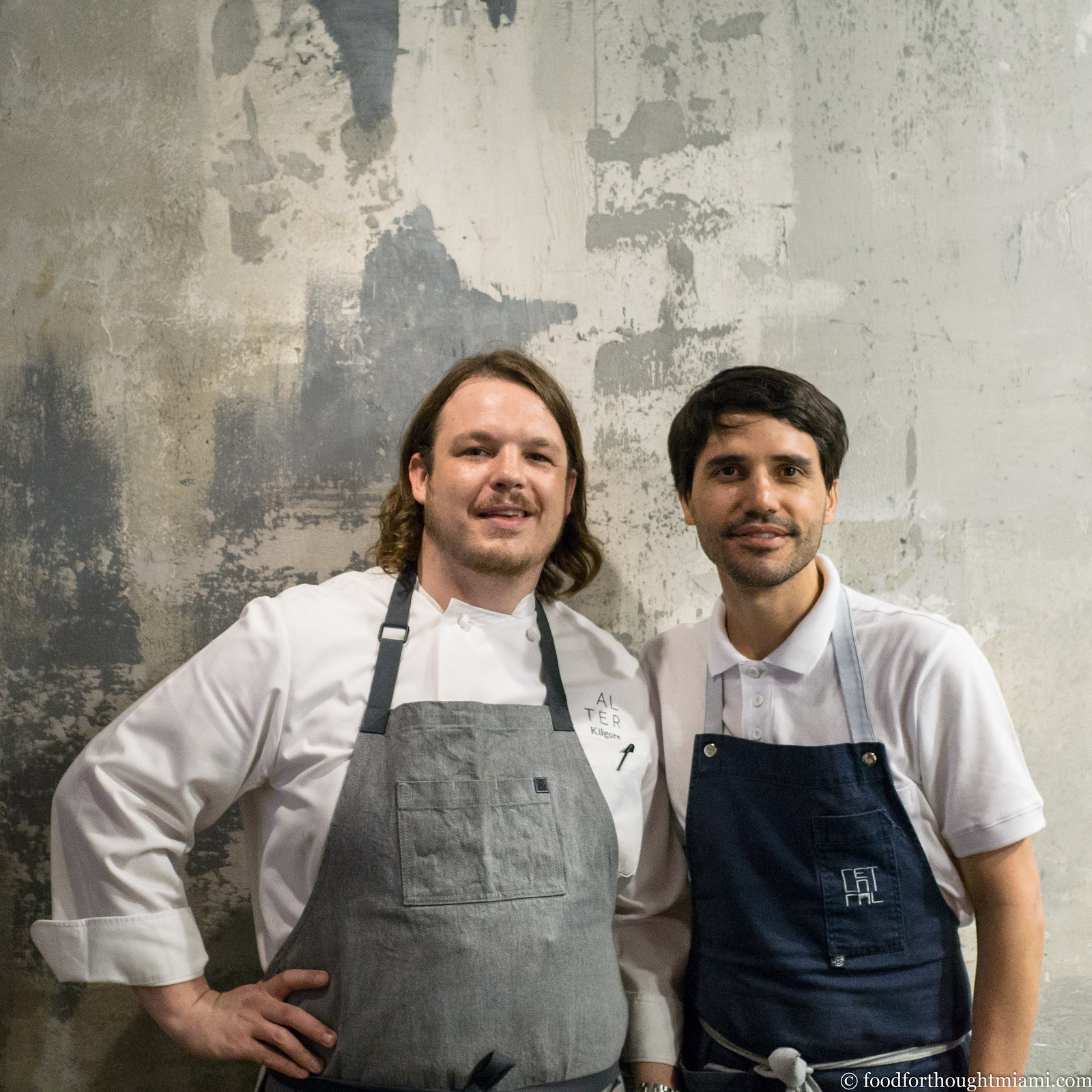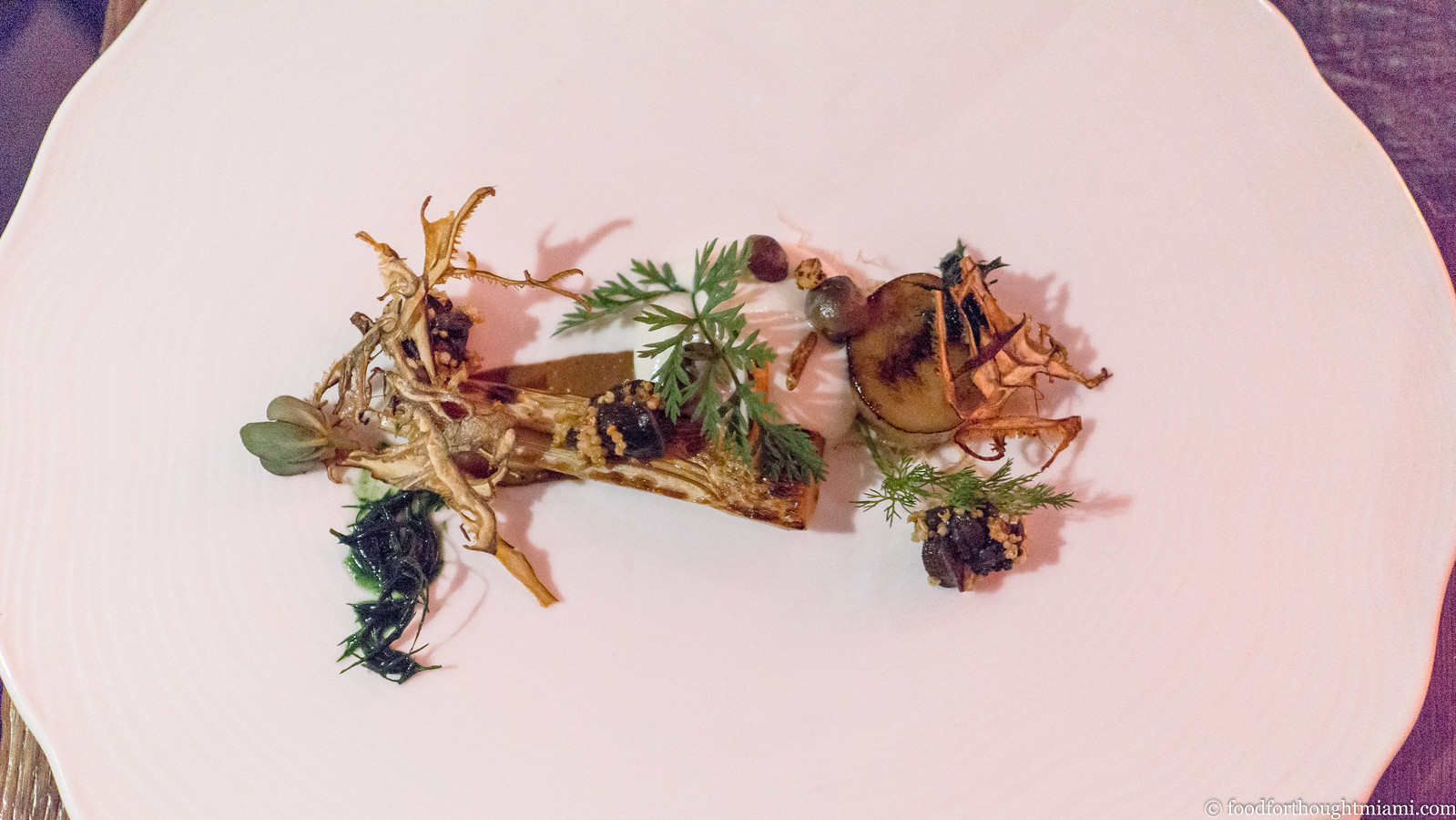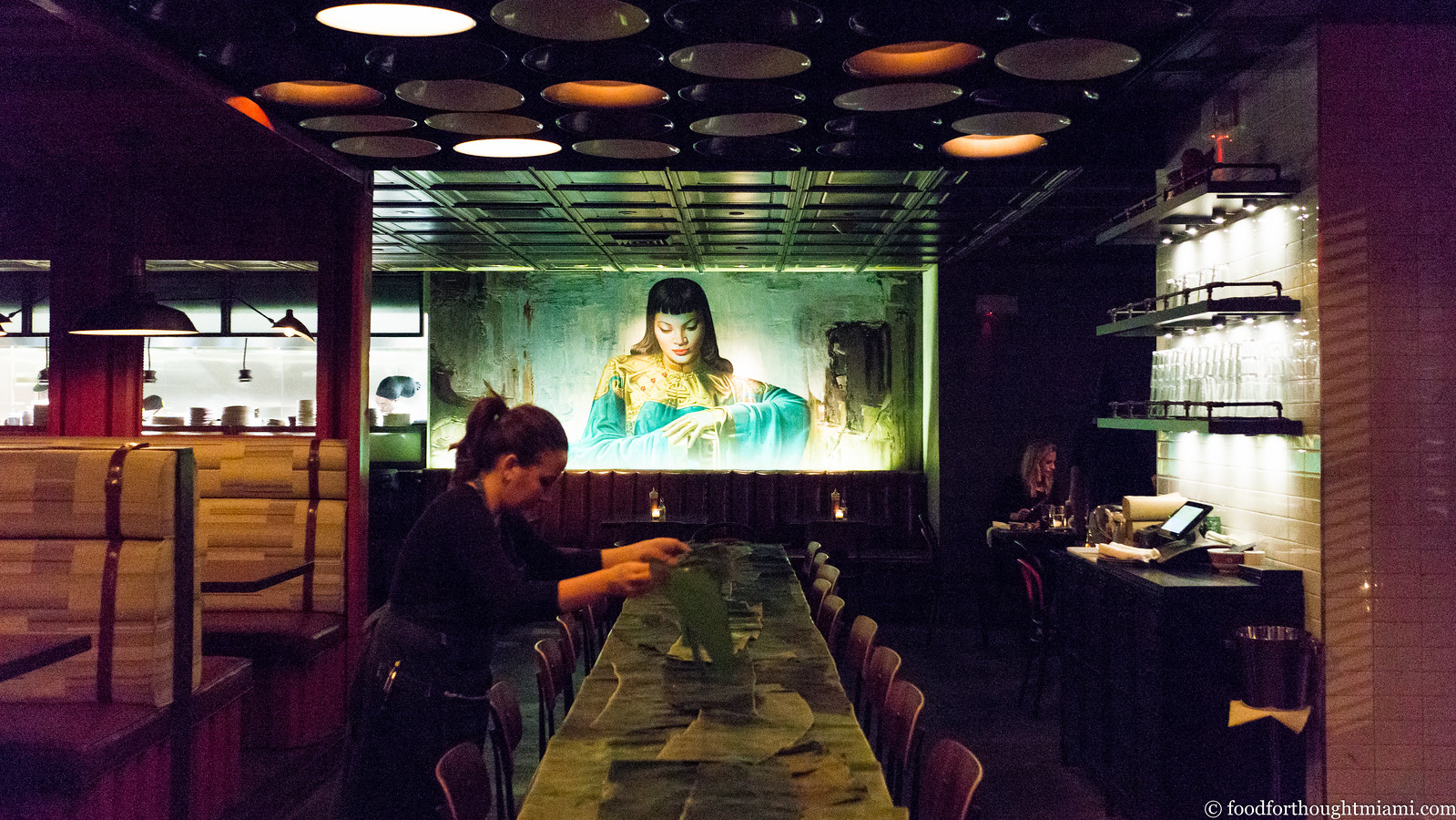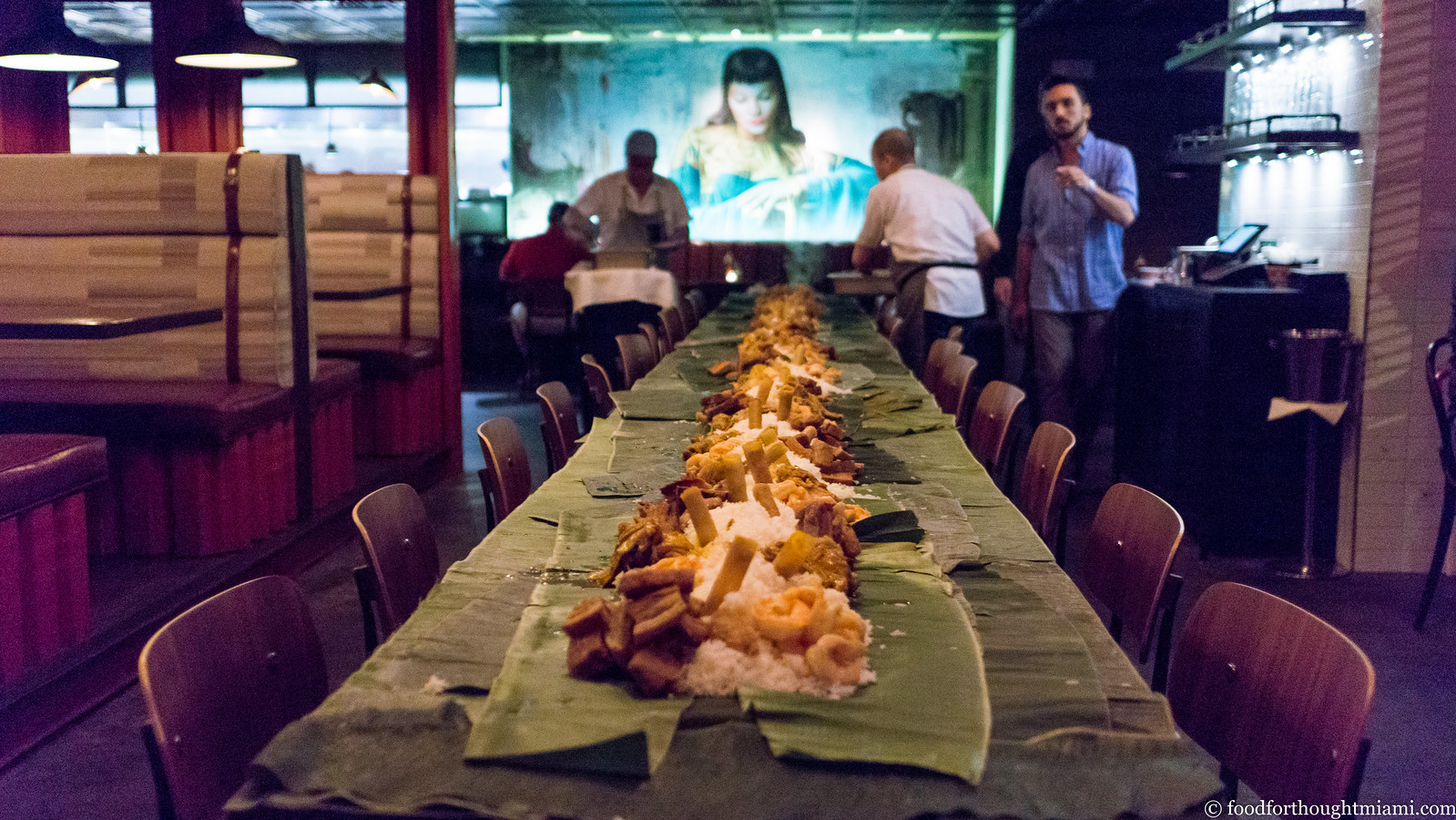Wednesday, June 22, 2016
Cobaya Muñoz at 1111 Peruvian Bistro
Diego Muñoz is a superstar chef. He spent the first part of his career working at some of the world's top restaurants: the Adriàs' El Bulli and Andoni Luis Aduriz's Mugaritz in Spain, Pascal Barbot's Astrance and Guy Martin's Grand Vefour in France, Massimo Bottura's Osteria Francescana in Italy, then off to Australia at Bilson's in Sydney. After literally cooking his way around the world, he returned home to Peru, where he ran the kitchen at Gaston Acurio's high-end tasting menu flagship, Astrid y Gaston, for four years. During Muñoz's tenure, Astrid y Gaston worked its way from No. 42 to No. 14 on the much-hyped (and much-criticized) S. Pellegrino World's 50 Best Restaurants list. When Ferran Adrià was in town last year for a "Gastronomy Congress" at Miami Dade College, Muñoz was one of the chefs on stage doing a demonstration, along with David Gil and Fran Agudo of brother Albert Adrià's restaurant, Tickets.
Then at the beginning of this year, Muñoz left Astrid y Gaston, with plans to embark on another year of world-wide cooking adventures. So when I stumbled across a small Peruvian restaurant that Muñoz had opened a few months ago in Miami, with no fanfare whatsoever – well, surprised would be an understatement.[1] We put the Cobaya wheels in motion to set up a dinner, which we were able to schedule while Muñoz would be in town this Friday.
Muñoz's restaurant, 1111 Peruvian Bistro, occupies the space that used to be home to BoxPark,[2] in the ground floor of the Axis Brickell condo building. It looks much the same, the most notable addition being a mural across the top of the open kitchen which appears to track Muñoz's career – I recognized the El Bulli bulldog, that shaggy sheep looks like the ones roaming the Basque countryside outside Mugaritz, the bowtie must belong to Tony Bilson, and there's Casa Moreyra, which houses Astrid y Gaston. At the end, beyond the palm tree, is 1111.
(You can see all my pictures in this Cobaya Muñoz at 1111 Peruvian Bistro flickr set).
Once we got everyone settled into a few communal tables, Chef Muñoz introduced himself to the group, and servers started bringing out the first round of an eight-plus course dinner.
Many food cultures have their versions of meat-on-a-stick. For Peruvians, it's anticuchos. Veal or beef heart may be the most traditional, but it could be just about anything: chicken livers, steak, fish, shrimp, or, as here, octopus. The meat had a nice spring to it without being chewy or bouncy, It had been rubbed with an anticuchera sauce bright with chiles, vinegar and spices, and was served over a creamy corn purée with a crispy potato alongside and a dab of salsa carretillera on top.
Peru's most famous dish, though, is surely ceviche. But Muñoz is not a traditionalist: he has made ceviches of sea urchin, clam, apple, melon, avocado, and I'm sure any number of other ingredients. Here, the base was the customary cubed whitefish, but it came swimming in a creamy, tangy leche de tigre, garnished with soft chunks of avocado and potent sliced fresh chiles, then given an Italian accent with briny capers and a drizzle of olive oil. It was a very good ceviche, and oddly reminiscent (in a good way) of a vitello tonnato.[3]
(continued ...)
Monday, June 13, 2016
best thing i ate last week: philly cheesesteak at Philly Grub
When I was in high school a long, long time ago, I worked one summer at a place called All American Heroes in the Aventura Mall food court. (It happened to be in the same space that was occupied by the gastroPod for a brief time last year). It offered the usual assortment of cold cut subs you'd find at any Subway wanna-be, but the real specialty of the house was the Philly cheesesteak. By the end of that summer, I fancied myself a legitimate cheesesteak-slinger, and had gotten pretty adept at that double-spatula chopping action on the flat-top.
You'd think that after having cooked countless hundreds of them, I'd also be absolutely sick of cheesesteaks. But that moment never came. At the end of my shift I'd still happily make myself one – usually with provolone, sometimes mushrooms (I was fancy even then) – and enjoyed it every single time.
So I was intrigued when I saw signage going up for a place called "Philly Grub" on a, well, pioneering stretch of NW 54th Street in Little Haiti that's often part of my daily commute. It opened a few months ago, but its hours (11am-6pm Mon-Sat, 11am-5pm Sun) never coincided with mine. I finally made it in this weekend, and was reminded of what I loved about that summer: the cheesesteaks.
(You can see a few more pictures in this Philly Grub flickr set).
There's not much to the place: a counter to take your order, a couple tables, a ledge around the wall with some stools. And there's not much to the menu either: your basic Philly cheesesteak, with a few options (Whiz, provolone or American; onions, peppers, mushrooms, lettuce, tomato and pizza sauce if you wish), along with a chicken cheesesteak, a vegetable Philly, plus sausage, meatball, and Italian cold-cut hoagies. But you'll appreciate the bare bones approach when you see that all the sandwiches are $7.76. Sides – Penn-Dutch style potato salad, a pretzel, or chips – will set you back an extra $1.76, or you can splurge on the pierogies with grilled onions and sour cream for $2.76. For Philadelphia nostalgists, there's also Italian water ices and TastyKakes for dessert.
It is a finely crafted sandwich that you'll get for your $7.76. The beef is tender, well-seasoned and cooked through – still juicy, not entirely dried out, but not sopping its way through the bread before you can finish. For tradition's sake, I abandoned the fancy pretensions of my youth and got crazy with the Cheez Whiz; there's a reason for those traditions sometimes. It comes on a real-deal Amoroso roll, with just the right balance of crusty and tender, like Peter Falk in Princess Bride.
That cheesesteak wasn't just the best thing I ate last week; it was almost as good as the ones I used to make.
You can read some more about Philly Grub and its owners in this piece in the Miami Herald.
Philly Grub
99 NW 54th Street, Miami, Florida
786.857.6906
Monday, June 6, 2016
best thing i ate last week: korean blood sausage by James Strine at Duck Duck Goose
P.I.G., the annual celebration of porcinity organized and hosted by Chef Jeremiah Bullfrog of the gastroPod, is consistently one of my favorite local food events of the year. It always seems to have good juju: the chefs bring their "A" game, the guests are in a good mood, the music's tight, the weather's right. So when Jeremiah said he was spreading his wings (sorry), and doing something called Duck Duck Goose, a P.I.G. style party but with an avian bent, featuring ducks from Lake Meadow Farm and D'Artagnan, I had high hopes.
I was not let down. It was a little steamy out there Saturday afternoon, but it was an auspicious first run for what I hope will become another regular event. Picking a favorite dish was tough. I could have easily named Aaron Brooks' (Edge Steak) arroz con pato, a sort of Peruvian paella infused with multiple layers of Peruvian chiles and cooked over an impressive open fire rig. Or Jeremiah's ma.po'outine, a hybrid of ma po tofu and poutine with duck fat fries and some serious ma la Sichuan zing. Or Brad Kilgore's (Alter) elegant foie gras and rabbit pavé with layers of fermented sunchoke yogurt and mushroom dashi gelée, crowned with golden raisins and preserved marigold petals. Or Steve Santana's (Taquiza) creamy, duck-fat enriched tamal colado served with pulled roast duck and a dark, rich mole negro.
But for me, it was the Korean style blood sausage that James Strine, from Café Boulud in Palm Beach, that stood out among several great dishes. The sausage – soft, meaty, with a ferrous tang – was bound with sweet potato noodles and sticky rice, and served with smoked duck and a tea-smoked duck egg, with everything brought into sharp focus by a pungent, cutting chile oil made from local Datil peppers, dried and infused into oil with other aromatics.
If you missed Duck Duck Goose, well, you missed out - you should hope, like I do, that it comes back around next year.
You can see all my pictures in this Duck Duck Goose flickr set, or flip through them here:
Friday, June 3, 2016
first thoughts: Doce Provisions | Little Havana (Miami)
I'd been meaning to ask Burger Beast, who is my expert on such things, what was his favorite Cuban sandwich in Miami. Then I found myself driving through Little Havana on the way back from court yesterday, and may have come up with my own answer to that question.
Doce Provisions is a pocket-sized restaurant on SW 12th Avenue, just a couple blocks north of Calle Ocho. (The spot used to be Alberto Cabrera's Little Bread). There's not much to it: a few tables, a counter along the wall lined with stools, and an open kitchen, though a roomier patio in back provides outdoor seating if weather permits. The menu is pretty tight too: the centerpiece is five varieties of sandwiches, bookended by several appetizer type items "para picar," and five bigger "family meal" options, all available in small or large portions.
(You can see all my pictures in this Doce Provisions flickr set).
The crumbly exterior of Doce's croquetas encases a filling of Miami Smokers[1] chorizo bound in a molten bechamel sauce. These would hold up well in a croqueta showdown with just about any others in town, save maybe Michelle Bernstein's ethereal versions. At $5 for four pieces, that's not too shabby. And while a "mostaza" dipping sauce tastes more of mayo than mustard, a delicate little side salad of frisée and slivered pickled peppers provides exactly the zing I was looking for.
It's a solid opening act to the main event: Doce's El Cubano. This Cuban sandwich is unorthodox in several respects. There's thin-sliced smoked pork loin and cured soppressata here, versus the traditional roast pork and ham.[2] The bread is neither the customary, flaky Cuban bread nor the sweet, eggy medianoche variation, but lies somewhere in between: the crumb more tender than the former, the crust a bit more substantial than the latter.
(continued ...)
Tuesday, May 31, 2016
best thing i ate last week: abalone at Aubergine + Alter dinner
A few months ago during a west coast jaunt, I had a really outstanding meal at Aubergine, Justin Cogley's restaurant in L'Auberge Carmel. One of the most interesting things was that in moments it could be hyper-local, while in others its makes (very good) use of product from literally clear across the globe. On the one hand, there's abalone farmed in Monterey Bay waters about five miles from the restaurant. On the other, there's densely marbled A5 wagyu beef from Hokkaido, Japan, about 5,000 miles across the Pacific Ocean.
Cogley brought both items with him when he came to do a collaboration dinner with Bradley Kilgore at his Wynwood restaurant, Alter. The good news is, they travel well. My favorite was the abalone: cooked so its flesh is springy but not tough, with a pure taste of the sea. Garnished with Carmel seaweeds and wispy lettuces, it swims in a sort of warm tea steeped with dried mushrooms, offering the depth and clarity of flavor of a well-made dashi. The dish was every bit as good as I recall it being in situ.
Honorable mentions to Brad's dish of venus clams with oseta caviar and potatoes over a yogurt purée, garnished with paper-like sheets of slow-cooked onion; to an outstanding dessert from Aubergine pastry chef Ron Mendoza which combined a candy cap mushroom mousse with fermented banana and shards of crisp chocolate; and to the plump, juicy pork shu mai at a late Saturday afternoon lunch at BlackBrick.
Monday, May 23, 2016
best thing i ate last week: parrillada at Los Fuegos
Months ago, I made my first visit to the new Faena Hotel, to try out Chef Paul Qui's restaurant, Pao (some first thoughts on Pao here). I was equally intrigued by its sibling at the Faena, Francis Mallmann's Los Fuegos, but hadn't made my way back. Mallmann, if you're unfamiliar, is a larger-than-life character who runs several restaurants in Argentina, and literally wrote the book which has inspired a new wave of interest in open-fire cooking. (For a good introduction, this episode of Chef's Table featuring him is highly recommended).
I pass up 99% of the freebie meal offers I get via FFT, but an invite to a Sunday asado at Los Fuegos was too good to pass up. So full disclosure and all, but hopefully I've built up enough credibility that you'll believe me when I tell you this was great stuff. Our afternoon junket took us through most of the Sunday menu, which is typically a $75 affair with several choices among three-plus courses. On special occasions (Father's Day is coming up ...) it will likely be more expansive, more expensive, and more family style, like what we were served.
There were lots of highlights – the wood oven baked empanadas, the grilled sweetbreads given a black-edged hard sear and a squeeze of burnt lemon, the bubbling provoleta with crusty bread – but the centerpiece was the parrillada, and the real standouts for me, the crisp-edged, tender-fleshed lechoncito, and the oozy, rich morcilla sausage.
(You can see all my pictures in this Los Fuegos by Francis Mallmann flickr set.)
I'll be back on my own dime soon.
Runner-up: the ultra-crispy Korean fried chicken, served in a puddle of kimchi-spiced yogurt, at Talde Miami Beach.
Friday, May 20, 2016
Aubergine @ Alter - May 24, 2016
I have not yet written about my dinner at Chef Justin Cogley's Aubergine in Carmel, California a few months ago, but it has stood out as one of the best meals I've had all year (see all the pics here). I've also only sparingly mentioned the series of collaboration dinners that local Chef Bradley Kilgore has been doing at his restaurant Alter in Wynwood. They've hosted two, and both times they've ended up in the "best thing i ate last week" report, and have been among the best meals I've had in Miami this year.
So you can probably guess that I was pretty excited to learn that the next Alter collaborative dinner will put chefs Cogley and Kilgore together at Alter. It's next Tuesday, May 24, and will feature an 8-course dinner created by the chefs in collaboration for $180 per person. I have it on good authority that Chef Cogley will be bringing with him a couple of the best things I ate at his restaurant a few months ago: some Monterey Bay abalone, sourced from waters within a couple miles of the restaurant; and the fantastic A5 wagyu beef that he sources from Japan. Aubergine pastry chef Ron Mendoza is coming too, and his desserts at Aubergine were also among the best I've had all year.
TL;DR - this event is highly recommended, and spots are still available.
Get your seats here.
Also – don't sleep on Duck Duck Goose, the avian version of Chef Jeremiah's great P.I.G. party, coming up on June 4. More info here.
Tuesday, May 17, 2016
best thing i ate last week: magurozuke nigiri at Myumi
Last summer, I wrote some "first thoughts" about Myumi – a food truck doing an omakase-only sushi service out of a lot in Wynwood. I came away impressed: fish, rice, knife-work, garnishes were all quite good, and indeed if I had any complaint, it was only that they could be a tad heavy-handed with the embellishments, hiding the quality of the base components. By Miami sushi standards, I rated it quite highly; for sushi coming from a food truck, it was downright exceptional.
Since I last wrote about Myumi, the truck moved a few blocks to Wynwood Yard, where it now shares space with a funky outdoor bar, Mortar & Pistil, a vegetable garden, as well as a few other food trucks. The sushi is still every bit as good as my initial experience, and now you can stroll a few steps and grab a cocktail or a beer (I highly recommend the locally made M.I.A. Megamix pale ale) to accompany your meal, and finish it with some frilly shaved ice cream from Mr. Bing.
The ten rounds that made up our omakase selection had about a 2/3 overlap with my earlier visit. This time around, my favorite bite among many good ones was the magurozuke, the glistening tranche of lean tuna marinated, if my taste buds are on target, in a blend of shoyu, mirin and dashi, and topped with a dab of fresh wasabi.
You can see the rest of the pictures from this meal towards the bottom of this Myumi - Miami (Wynwood) flickr set.
Monday, May 16, 2016
first thoughts: Dragonfly Izakaya | Doral
Nearly a year ago, I posted some thoughts prompted by an Eater "Future Week" feature on the future of Miami dining. One of the things I predicted was that we would start seeing more independent restaurants in less trendy neighborhoods: places like Doral and Kendall, with lower rents, lots of potential customers, and not much competition other than chains. I'll confess that as a Miami Beach resident, I don't get out that way very often (honestly, I'd usually rather chew off one of my own limbs than drive on SR-836 West). But I braved the westward traffic last week to pay a visit to Dragonfly Izakaya, which opened last month.[1] The menu, which promised seafood from Tsukiji Market and robata-grilled "neck to tail" yakitori, had lots of the right words on it.
(You can see all my pictures in this Dragonfly Izakaya and Fish Market flickr set.)
It's a big venue, with a long and busy indoor/outdoor bar, seating for probably about 100, and an open kitchen with a robata grill and sushi bar. At the entrance is a small space that's slated for use as a fish market, though it's not yet up and running. Dragonfly's a good-looking room, which incorporates Japanese elements into the design – big sake barrels, wooden planks over the robata grill with the menu written in kanji – but not in a completely over-the-top Epcot kind of way.
We started at the bar, which during happy hour features $7 cocktails (including a nice pre-batched Old Fashioned) and several sub-$10 snacks, including a solid rendition of chicken karaage for $5 (that's not the entire portion – someone ate half of it before I got there). After the happy hour clock wound down, we shifted our way over to the sushi bar to sample through the rest of the menu.
We started with a round from the robata grill. The selection was not as broad as the menu promised: a "Neck-to-Tail Tasting Menu" listed several of the more exotic chicken bits, but some of my favorites were not yet available: bonjiri (chicken butt, from the end of the tailbone), seseri (neck, with lots of nice crispy skin) and tsukune (ground chicken meatballs, not sure why these would be so difficult to drum up). But we still did OK – pictured here and working clockwise from top left, eryngii (king oyster mushrooms) doused with butter and lemon, reba (chicken liver) swiped with tare, kawa (crisp, fatty chicken skin), and shio saba (salted mackerel). In the bottom left corner is one of my favorites, okonomiyaki, a sort of savory Japanese pancake studded with cabbage and seafood, then bedecked with Kewpie mayo, okonomi sauce, aonori, beni shoga (red pickled ginger), and wispy bonito flakes. Off-screen: tontoro, grilled pork cheek, served with a nutty sesame oil dipping sauce.
Of these, the highlights were the saba – it was powerfully salty, but the mackerel was tender, oily and fishy in a welcome way – and the okonimiyaki, a treat that's difficult to find here in Miami. The chicken items were good, but lacked that fantastic balance of juicy and crisp that I've experienced at yakitoris in Japan (though that's setting the bar pretty high).
We followed with a round of nigiri: here, from back to front and left to right, hamachi (yellowtail), saba (mackerel), hotate (scallop), ika (squid), ikura (salmon roe), and mirugai (geoduck). Off-screen: ama ebi (sweet shrimp), served in the customary fashion accompanied by their fried heads. Again, the offerings on hand were a bit shy of what was listed on the menu: no o-toro, uni or aji. no kinmedai or aji from Tsukiji market. But from what we sampled, the fish was of pretty good quality – I especially enjoyed the firm snap of the mirugai. The rice was a bit cold, stiff and underseasoned for my taste. The chef also sent over a tuna kobashi for us to sample, with ruby-hued cubes of fish given a riveting dash of kimchi spice and a savory hit of toasted sesame oil, served with slivered avocado and airy rice crackers for some DIY Japanese nachos.
(continued ...)
Tuesday, May 10, 2016
travelogue: a weekend of eating in Cartagena
Let me just betray my own ignorance immediately: when a good friend said he was getting married in Cartagena, I had absolutely no expectations of the city whatsoever. I was going for the wedding, and didn't really give much thought to what else the destination might hold. I booked a flight (direct out of Fort Lauderdale on JetBlue, and quite cheap, I should note) and started looking for a hotel near the church where the ceremony would be. And as I was searching on Google Maps, those little pictures of the spots you're clicking started popping up – and like a dummy, I realized, "Oh. This place actually looks really nice!"
The heart of Cartagena, the Old Town, is a walled city overlooking the Caribbean coast which has long been attractive to empire builders, tomb raiders, slave traders and pirates. Its winding streets are lined with Spanish colonial buildings and dotted with plazas and churches that date back to the 16th century. About half of those buildings are beautifully preserved; the other half are in a state of often remarkable decay, the kind of ruin porn that draws people to Cuba and Detroit. (With its designation as a UNESCO World Heritage Site, all the facades must be kept intact, though owners will often adapt and re-purpose the interiors).
It is about as picturesque a place as I have ever seen, yet still has the feel of a lived-in city and not some sort of Potemkin village. I was completely charmed by it.
We only had a weekend to explore, and a wedding to celebrate and related events to attend, but in between the festivities, here's what we did while in Cartagena:
(All the places we visited, and many more, are bookmarked in this Cartagena Google Map; you can also see all my pictures from around the city in this Cartagena, Colombia flickr set).
Our home base was the Hotel Quadrifolio, which was two blocks from the chapel in the heart of the Old Town. It's an eight-room boutique hotel in a beautifully restored old 17th century residence. As we checked in – while sitting in what was more of a living room than a lobby, and sipping on delightfully cold, slushy mojitos – we flipped through a picture book with before-and-after shots of the restoration. The transformation is remarkable.
The rooms are all situated around a central courtyard lined with arched passageways. A small indigo-tiled pool is nestled in back. Despite the tropical heat, the A/C in our room blasted at arctic levels, while the bathroom was open-air, with a small garden next to the shower. The decor throughout the property seamlessly merges the contemporary and the pre-Columbian. It was a glorious place.[1]
(There are more pictures of the hotel in this Hotel Quadrifolio flickr set.)
Hotel Quadrifolio
Calle del Cuartel (Cra. 5) No. 36-118, Cartagena de Indias, Colombia
+575 664 6053
We dropped our bags and went exploring the town, running into several other wedding attendees along the way. Though it's less than a mile from one side of the Old Town to the other, we would see something new every time we wandered the criss-crossing streets: an impeccably preserved church here, a beautiful but crumbling facade a block away.
And everywhere there were fruit vendors, with carts stacked with mangoes, papayas, coconuts, pineapples, and other more exotic specimens: maracuya (passionfruit), lulo, tomate de arbol, guava, granadilla and more.
Though we knew there would be food at a reception for the wedding guests that night, I was feeling peckish around mid-afternoon, and we stopped off for our first bite at La Cevicheria. We chose it primarily because it was open in mid-afternoon, and most places in town close at 3pm until dinner service (I get the sense that siesta is still taken pretty seriously here). I learned later that this is on the W.W.B.D. ("What Would Bourdain Do?") list for Cartagena, and I can see why.
Maybe I was especially hungry. Maybe the charm of the town makes everything taste better. Maybe it was their good A/C or their cold beer.[2] But this octopus ceviche, was, in the moment, one of the best ceviches I'd ever had. The octopus hit that satisfying equilibrium between tender and chewy, speckled with diced onions and peppers, all awash in a citrusy marinade stained dark brown by the octopus' pigment. You can also adjust the heat level yourself with a bottle of a really outstanding orange-hued hot sauce that our server was good enough to clue us in on.
La Cevicheria's ceviches are served with saltines for scooping, but for a worthwhile upgrade, get an order of their tostones, the plantains flattened wafer-thin and fried until shattering crisp.
(There are a few more pictures in this La Cevicheria flickr set.)
La Cevicheria
Calle Stuart 714, Cartagena de Indias, Colombia
+57 5 660 1492
(continued ...)
Friday, May 6, 2016
Duck Duck Goose! June 4 in Wynwood
I've repeatedly said here that P.I.G., the annual porcine production hosted by Chef Jeremiah Bullfrog, is one of my favorite Miami food events of the year. (Most recently last November for P.I.G. #6.) Well, now the P.I.G. is spreading its wings.
On June 4, Chef Jeremiah's gastroPod will play the host of "Duck Duck Goose." Whereas P.I.G. is a celebration of all things pig-related, this one is for the birds: a great lineup of guest chefs cooking locally pastured poultry, including ducks from Lake Meadows Farm. Expect a flock of ducks, hopefully some geese, and lots of live fire cooking over embers. So what's with all the birds? Says Jeremiah: "After seven years of cooking pig, we thought it might be sustainable to switch up farm animals."
The chefs include some P.I.G. regulars and some new additions: Brad Kilgore of Alter, Will Crandall of Izzy's Fish and Oyster, James Strine of Café Boulud, Patrick Rebholz of Quality Meats, Cake from Cake Thai Kitchen, Gabriel Ask from the Faena, Aaron Brooks of Edge Steak, Steve Santana of Taquiza, Brian Mullins of Ms. Cheezious, Babe Froman Fine Sausages, and John Lermayer, mixologist from Sweet Liberty.
The deets:
When: June 4, 2016 from 5pm-9pm
Where: gastroPod, 168 NW 26th Street, Miami (Wynwood)
Tickets: $59 - get 'em through Eventbrite
It's the same basic idea - get some great chefs together to all cook good things with tasty animals - but Jeremiah says Duck Duck Goose will have a somewhat different feel from the P.I.G. fests: "PIG is more of a Rock n Roll and Whiskey vibe. With DDG, the aim is towards Champagne and Bossa Nova." So imagine something like this:
But with a duck, and a different soundtrack. Sounds good to me.
Monday, April 25, 2016
best thing i ate last week: oysters frank at Mignonette
There are so many new places that have opened in Miami of late; and yet sometimes – often – I just want to go back to an old favorite. Mignonette, Chef Daniel Serfer's oyster bar in Edgewater, has become one of those old favorites: a place where I might very well order the same thing every time I go, and always leave happy.
But here's something new: "Oysters Frank," named after chef de cuisine Bobby Frank. Topped with smoked bacon, manchego cheese, a goodly amount of butter and a dash of sherry, then broiled, these will give Mignonette's excellent rendition of Oysters Rockefeller a run for their money. Round out the rest of the meal with their very good lobster deviled eggs, one of my favorite salads, and a fancy seafood tower, and I bet you'll leave happy too.
Monday, April 18, 2016
best thing i ate last week: grilled eggplant salad at Vagabond Backyard Cookout
I'm a big fan of all the good things happening in Miami's "MiMo District" along Biscayne Boulevard, anchored of late by the refurbished Vagabond Motel. Yes, it's partly because it's a straight shot from home across 79th Street Causeway for me, but it's also because the neighborhood has some old 1950's Miami feel, which many of its new inhabitants are looking to preserve in some fashion while still bringing new styles and flavors.
So I was particularly happy to see Chef Alex Chang, who runs the Vagabond Restaurant, team up with Chef Phuket Thongsodchaveonde of Cake Thai Kitchen up the street for a Backyard Cookout around the Vagabond pool. Two of my favorite spots, at one event? Sold.
Together they did a Thai-style BBQ that included grilled corn slathered with coconut cream and palm sugar, a fragrantly spicy Isaan style pork shoulder larb dusted with roasted rice powder, BBQ chicken with papaya salad and sticky rice, grilled whole fish cooked in banana leaves, and for dessert, an ice cream sandwich tucked into a hot dog roll topped with toasted peanuts and fish sauce caramel (a LOT better than it might sound).
(You can see all my pictures on the back end of this Vagabond Restaurant flickr set).
But my favorite dish was this eggplant salad. Little golf ball sized Thai eggplants were halved and grilled so their edges blackened and their insides had just started to go soft and custardy. They were doused in a key lime vinaigrette packing sour, sweet, and just a little heat. But the clincher was the toppings: those crispy shallots, those chewy, funky dried shrimp, like little flavor bombs that keep you digging in for another bite.
It was the best thing I ate last week, and a really fun way to spend a Sunday afternoon.
Monday, April 11, 2016
Cobaya #61 at 27 with Chef Jimmy Lebron
This is another one we've been trying to make happen for quite some time. Finally, all the right pieces fell into place and we had a date locked in for a Cobaya dinner at 27 Restaurant, the sibling to the wonderful Broken Shaker bar at the Freehand Hotel on Miami Beach.
27 is one of my favorite places on the Beach, foregoing the glitz and glam that's becoming ever-present for a cozy, homey atmosphere with the feel of an abuela's casita – if your abuela was also Israeli and had a thing for craft cocktails. The regular menu at 27 does a remarkable job of capturing that vibe as well: it's fresh and unfussy, and though visitors may puzzle over why arepas, shakshuka and kimchi fried rice are all coming out of the same kitchen, it somehow tastes and feels more like Miami than just about any other restaurant in town.
The Freehand actually played host to Cobaya #29 with Brandon Baltzley a few years ago, but this one would be an in-house affair. So Chef Jimmy Lebron was in charge, and we invited him to craft his own menu for forty guinea pigs. What he came up with was simultaneously unique and fully in the spirit of the place at the same time.
(You can see all my pictures in this Cobaya #61 at 27 Restaurant flickr set).
We gathered at 27's upstairs bar and sampled the cocktails as the group assembled, then made our way back downstairs and settled in at a few communal tables stretched across the restaurant's multiple rooms. All the courses were served family style, and it had more of the feel of a dinner party than a restaurant meal.
After starting us off with some malawach, a Yemenite fry-bread, served with a really delicious uni butter dusted with za'atar spice, Chef Lebron sent out a round of "Fresh from Florida" seafood courses: Peruvian-inspired steamed middleneck clams swimming in a tangy leche de tigre, with salsa criolla and cancha corn; a crudo of fresh, sweet mangrove snapper, paired with ripe local loquats, tangerine juice, and a surprising – and really magical – dash of Chartreuse; a salad of green papaya from my CSA farmer, Little River Cooperative, with Thai chiles and halloumi cheese, which was one of the best versions I've ever had; and whole black belly rose fish[1] done in an escabeche style, fried whole and topped with pickled vegetables.
(continued ...)
Wednesday, April 6, 2016
travelogue: a weekend of eating in New York City
Whenever we visit New York City, there's a constant tug of war between the new and the familiar. We're typically only in the city for a couple days at a time, and the list of places I'd like to try runs into the hundreds; but there are also the places to which we like to return, rituals that provide reward and reassurance through repetition.
When we can do so for a not-astronomical rate, we like to stay at The NoMad, which aside from having a great restaurant and a great bar,[1] also has posh but comfortable rooms, great service, and a central location (28th and Broadway) from which both Lower Manhattan and the heart of Midtown are within range of a long walk. That's the view from our room down into the dining room at the top of this post; the view at ground level is equally nice.
(You can see all my pictures from The NoMad in this NoMad flickr set).
And when we stay at the NoMad, and arrive mid-afternoon, we like to drop our bags and get a snack at the John Dory Oyster Bar, April Bloomfield's seafood emporium one block up. Since it's between services, there's only a limited menu, which is fine: some oysters, a carta di musica, and a couple other fishy things (this time, a smoked char pâté with parker house rolls and half of a poached lobster) tide us over in very happy fashion until dinner.[2]
(You can see all my pictures from the John Dory in this John Dory Oyster Bar flickr set).
The John Dory Oyster Bar
1196 Broadway @ 29th Street, New York, NY
212.792.9000
For dinner, though, something new (for us anyway): Sushi Ko, an 11-seat, omakase only sushi den on the Lower East Side. Part of the draw for me was that the itamae, John Daley, was a mentee of Masato Shimizu, the chef of 15 East where we'd had an excellent meal a couple years ago.[3] After working at 15 East, Daley went to Japan and worked for Chef Masa's mentor, Rikio Kugo of Sukeroku. At his own place – which he runs pretty much as a solo operation, which just one server pouring drinks and handling the check – he serves a $150 procession of about a dozen and a half rounds of nigiri.[4]
His rice I thought was very good: faintly warmer than body temperature, each grain perfectly distinct without falling apart, seasoned just enough to enhance but not overwhelm the flavor of the rice itself. Though Daley has been characterized as something of a renegade, he is not the type that festoons his neta with a blizzard of different garnishes. Some were smoked or quickly seared, but otherwise his fish was touched only with a delicate swipe of wasabi, a brush of soy sauce or a sprinkle of salt, and maybe a touch of citrus juice or zest. I did find he was a bit heavy-handed on the salt, but this was something I could have remedied had I recognized it earlier: early in the meal, he invited each of us to ask him to calibrate his seasoning.
I liked how his selection of fish had themes: kanpachi fresh in one instance and lightly smoked in another; shima aji and aji in procession; three different kinds of uni (California uni, smoked, as nigiri; Maine uni in a maki; Japanese uni as gunkan maki) over the course of the meal; though I wished one of those themes hadn't been (endangered) wild caught Atlantic bluefin tuna.[5]
New York Sushi Ko
91 Clinton Street, New York, NY
(continued ...)
Monday, March 21, 2016
best thing i ate last week: everything at the Central + Alter dinner
Don't make me pick a favorite. I just can't.
Last Tuesday was the second collaborative dinner hosted at Alter restaurant by Chef Bradley Kilgore. This time, he brought in Chef Virgilio Martinez of Central in Lima, Peru. These kinds of team-ups can be something of a crap shoot for the diner: even with talented chefs, it's unpredictable how effectively their styles will mesh, or how well someone's cooking may show on the road.
Yet this dinner was so in tune that for most of the night I couldn't tell who had cooked which dish, other than that Virgilio's sometimes had a tell: if I had to google an ingredient, it was one of his.[1] But regardless of the creator, everything - everything! - at this meal was exceptional. If I had to narrow it down to two:
(You can see all the pictures in this Central @ Alter flickr set.)
"Valley Between Andes" – I later figured out that Martinez's menu at Central features dishes inspired by the products of different elevations of the Peruvian topography. This one included avocado, tree tomato (a/k/a tamarillo), and kiwicha (amaranth seeds). The avocado was so creamy and rich that it almost ate like tender braised beef, napped with a tangy sauce and speckled with the nutty, quinoa-like kiwicha, with shards of translucent, herb-dotted crackers for some textural contrast.
"Fallen Tree" – Brad started with a caramelized tranche of heart of palm as the base of the dish, with the other components evoking a tropical forest floor: snails, dehydrated mushrooms, a tangle of green (seaweed?) moss, a pouffe of spring garlic mousse with pickled honshimeji mushroom "spores" poking up out of it.
But these are just examples – every course of this menu impressed. It's unusual to have so many dishes that simultaneously achieve the delicious, the beautiful, and the unexpected all at once.
[1] I.e., kiwicha (amaranth seed, a pseudocereal like quinoa), tree tomato (which I'm more familiar with as "tamarillo"), airampo (a magenta hued prickly pear fruit), chaco clay (an edible clay which apparently has been consumed since pre-Colombian times).
Monday, March 14, 2016
best thing i ate last week: razor clams and rice at Bazi "kaiseki" dinner
I was surprised when I heard that pasta master Michael Pirolo of Macchialina was opening an Asian-inspired restaurant – Bazi. Pirolo's culinary upbringing is Italian through and through. He was raised in Italy, went to culinary school in Torino, and did apprenticeships in Bologna and the Piemonte. The first kitchen he ran as chef de cuisine was Scott Conant's Scarpetta, then he went out on his own with Macchialina (originally opened with the Pubbelly boys, but from whom he split a few years ago).
I didn't see how an Asian restaurant fit with that resume and, to be very candid, figured the motivation was money rather than passion. My theory was thrown into doubt, though, when Bazi recently announced it would start doing a special "kaiseki" style dinner on Wednesday nights for up to eight people at the downstairs bar. Not that $150 per person is exactly giving food away, but considering it's for a ten-course dinner inclusive of drink pairings, tax and tip, it doesn't seem like much of a money-maker either.[1] This is the kind of thing a chef does because they really want to, and maybe because they're a little crazy.
Let's not dwell too long on how much this truly resembles a traditional Japanese kaiseki dinner (short answer: not too much).[2] Instead, let's talk about the best thing I ate last week: the clams and rice dish Pirolo served as one of the courses.
(You can see all my pictures in this Bazi Kaiseki Dinner flickr set).
In this one dish, Pirolo ties together his Italian background and his Japanese ambitions. Diced razor clams are combined with chewy but tender viaolone nano rice, all served in the clam's shell. The rice is prepared in classic "all'onda" fashion, and bound with the clams by an uni vinaigrette which further highlights the flavors of the sea. A shower of fresh lemon balm adds a bright, herbaceous, citrusy note. It's a beautiful dish.
It was a close call between this, the chicken wing stuffed with five-spiced foie gras torchon, the black cod stuffed with Key West shrimp and Alaskan king crab with a nasturtium and avocado purée, and the roasted squab served with a coconut and ginger rice fritter. If that many dishes were in the mix, that's the sign of a pretty good meal. If you're interested, maybe check it out yourself this coming Wednesday.
Bazi
1200 Collins Avenue, Miami Beach, Florida
305.695.0101
[1] Full disclosure: Chowfather and I were guests of the house for this first of their Kaiseki Dinner Series. Had I been spending my own hard-earned dollars, however, I'd still have felt this was a pretty good value. Ten courses, several featuring at least some small doses of luxury ingredients like osetra caviar, uni and foie gras. A pairing with each course by Will Rivas, the talented beverage director of Bazi and Macchialina, including cocktails, sakes (some fruit-infused in-house), smartly selected wines, a rare Japanese beer, and a couple JoJo teas. With tax and tip included. You can spend $150 on a meal in Miami and do far worse.
[2] Longer answer? To my admittedly extremely limited knowledge, most of which is derived from the gorgeous book "Kaiseki" by Yoshihiro Murata (of Kikunoi restaurant) and a couple meals in Japan, there are a few key components to kaiseki. One is the procession of courses, which typically follows a certain pattern though there is some room for variation. Another is the importance of seasonality, with dishes and presentations that attempt to capture a particular moment in time (and consequently are often locally sourced as well). Finally, and linked indelibly to the seasonality component, is the focus on the ingredients themselves; presentations and plating can be rather ornate, but the dishes themselves are often quite elemental – not so much austere as serene, if that makes any sense.
Pirolo's menu paid some heed to the traditional kaiseki progression, without being mindlessly obedient to it. He started with "sakizuke," effectively an amuse-bouche, followed by "hassun," typically an assortment of several different seasonal items, then a sashimi course. Where there are usually then a series of simmered dishes and soups, often followed by a grilled fish, Pirolo took a detour through a series of dishes that didn't really have much traditional antecedent. But whatever – they were some of the best courses of the night. I did miss one of my favorite parts of the typical progression: a rice dish, typically served with pickles and soup, as the final savory item before dessert.
But what I felt was missing more than the progression was the seasonal, local element. There were lots of great dishes; but the ingredients were from literally all over the map, not much of it local, and not seemingly connected much to the season. Perhaps on a related note, too many dishes seemed to be more about the preparations than the ingredients themselves. For instance, with three fish used in the sashimi course, none were local and none were actually served raw: the arctic char was cured, the escolar was marinated in koji, the eel was grilled. This was also probably my least favorite course of the evening; while I have huge respect for Pirolo bringing in live eels and tackling the task of butchering and preparing them from scratch, I'm not convinced the end result is better – or more to the point, more in the spirit of "kaiseki" – than a simple preparation of pristine, fresh local fish.
Personally, I'd love to see a menu that's more about the ingredients, and less about what's been done with them. In this sense, I think Chef Kevin Cory's omakase dinners at Naoe – though he doesn't call them "kaiseki" – are actually much closer to that spirit. And if Pirolo called these "omakase" dinners rather than "kaiseki," I could spend a lot less time spinning wheels in my own head over whether that term really makes any sense here, and instead just focus on the food, which is what I'm really trying to do in this post, other than in this overlong footnote.
[2] Longer answer? To my admittedly extremely limited knowledge, most of which is derived from the gorgeous book "Kaiseki" by Yoshihiro Murata (of Kikunoi restaurant) and a couple meals in Japan, there are a few key components to kaiseki. One is the procession of courses, which typically follows a certain pattern though there is some room for variation. Another is the importance of seasonality, with dishes and presentations that attempt to capture a particular moment in time (and consequently are often locally sourced as well). Finally, and linked indelibly to the seasonality component, is the focus on the ingredients themselves; presentations and plating can be rather ornate, but the dishes themselves are often quite elemental – not so much austere as serene, if that makes any sense.
Pirolo's menu paid some heed to the traditional kaiseki progression, without being mindlessly obedient to it. He started with "sakizuke," effectively an amuse-bouche, followed by "hassun," typically an assortment of several different seasonal items, then a sashimi course. Where there are usually then a series of simmered dishes and soups, often followed by a grilled fish, Pirolo took a detour through a series of dishes that didn't really have much traditional antecedent. But whatever – they were some of the best courses of the night. I did miss one of my favorite parts of the typical progression: a rice dish, typically served with pickles and soup, as the final savory item before dessert.
But what I felt was missing more than the progression was the seasonal, local element. There were lots of great dishes; but the ingredients were from literally all over the map, not much of it local, and not seemingly connected much to the season. Perhaps on a related note, too many dishes seemed to be more about the preparations than the ingredients themselves. For instance, with three fish used in the sashimi course, none were local and none were actually served raw: the arctic char was cured, the escolar was marinated in koji, the eel was grilled. This was also probably my least favorite course of the evening; while I have huge respect for Pirolo bringing in live eels and tackling the task of butchering and preparing them from scratch, I'm not convinced the end result is better – or more to the point, more in the spirit of "kaiseki" – than a simple preparation of pristine, fresh local fish.
Personally, I'd love to see a menu that's more about the ingredients, and less about what's been done with them. In this sense, I think Chef Kevin Cory's omakase dinners at Naoe – though he doesn't call them "kaiseki" – are actually much closer to that spirit. And if Pirolo called these "omakase" dinners rather than "kaiseki," I could spend a lot less time spinning wheels in my own head over whether that term really makes any sense here, and instead just focus on the food, which is what I'm really trying to do in this post, other than in this overlong footnote.
Saturday, March 12, 2016
Cobaya Kamayan with Chef Dale Talde
We encourage chefs to think of a Cobaya dinner as a chance to do something different, something they typically couldn't otherwise pull of in their restaurants. Chef Dale Talde of Talde Miami Beach (and also of Talde Brooklyn, Talde Jersey City, Pork Slope and Thistle Hill) got the message.
(You can see all my pictures in this Cobaya Kamayan with Chef Talde flickr set).
We gathered in the restaurant's bar as our twenty-five guinea pigs made their way to Mid-Beach. Though Talde is inside the Thompson Hotel, it ditches the typical bland, anonymous feel of a hotel restaurant for a hodge-podge of Asian-Americana and hip-hop motifs: behind the hostess stand is a tongue-in-cheek portrait of Talde with a couple bikini-clad models all holding plates of food; one wall is covered with a street art style picture of a tangle of ramen noodles.
As we were assembling our guinea pigs, the Talde crew was getting ready for us, spreading out layers of banana leaves on one long communal table. Though Talde describes his style as "proudly inauthentic" Asian-American cooking, this was going to be a meal with a genuine connection to his Filipino ancestry: a kamayan feast.
What does that mean? From what I can gather from a few minutes of Googling, "kamayan" literally means "with your hands," and derives from a pre-colonial tradition in the Philippines of eating with one's hands. The Spaniards of course saw this as "uncivilized," and brought with them the use of cutlery. But great eating traditions don't die easily, and there is a real pleasure and sense of community in everyone literally digging into a meal with their hands. I've also seen the same thing described as a "boodle fight," referring to a Filipino military custom in the same style where soldiers and officers, regardless of rank, all eat with their hands from the same table.
So as we entered the dining room (after making sure everyone washed their hands), we found one long table covered in banana leaves, and then piled high with dinner for twenty-five. No plates, no utensils, just a lot of food – and a lot of napkins.
(continued ...)
Subscribe to:
Posts (Atom)

